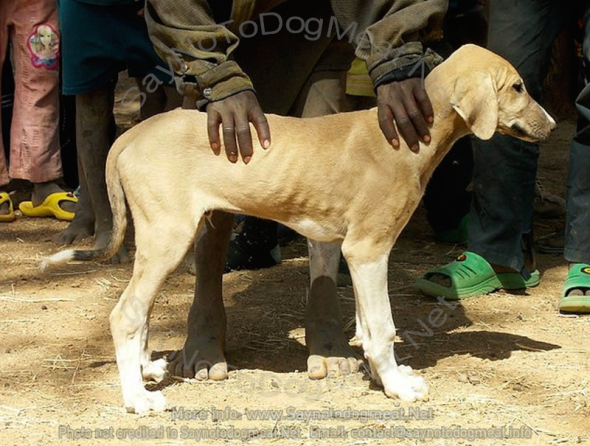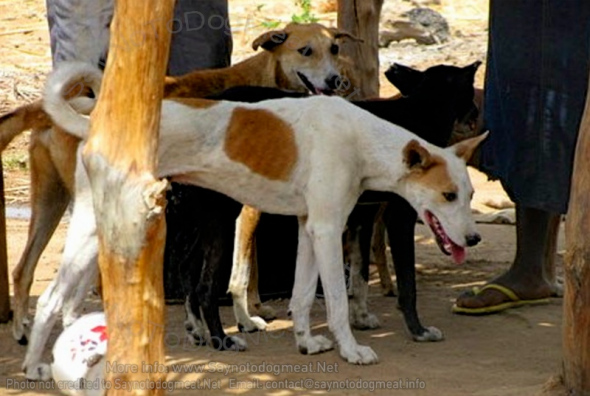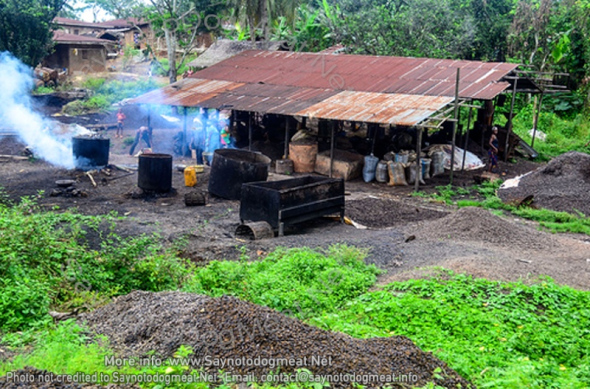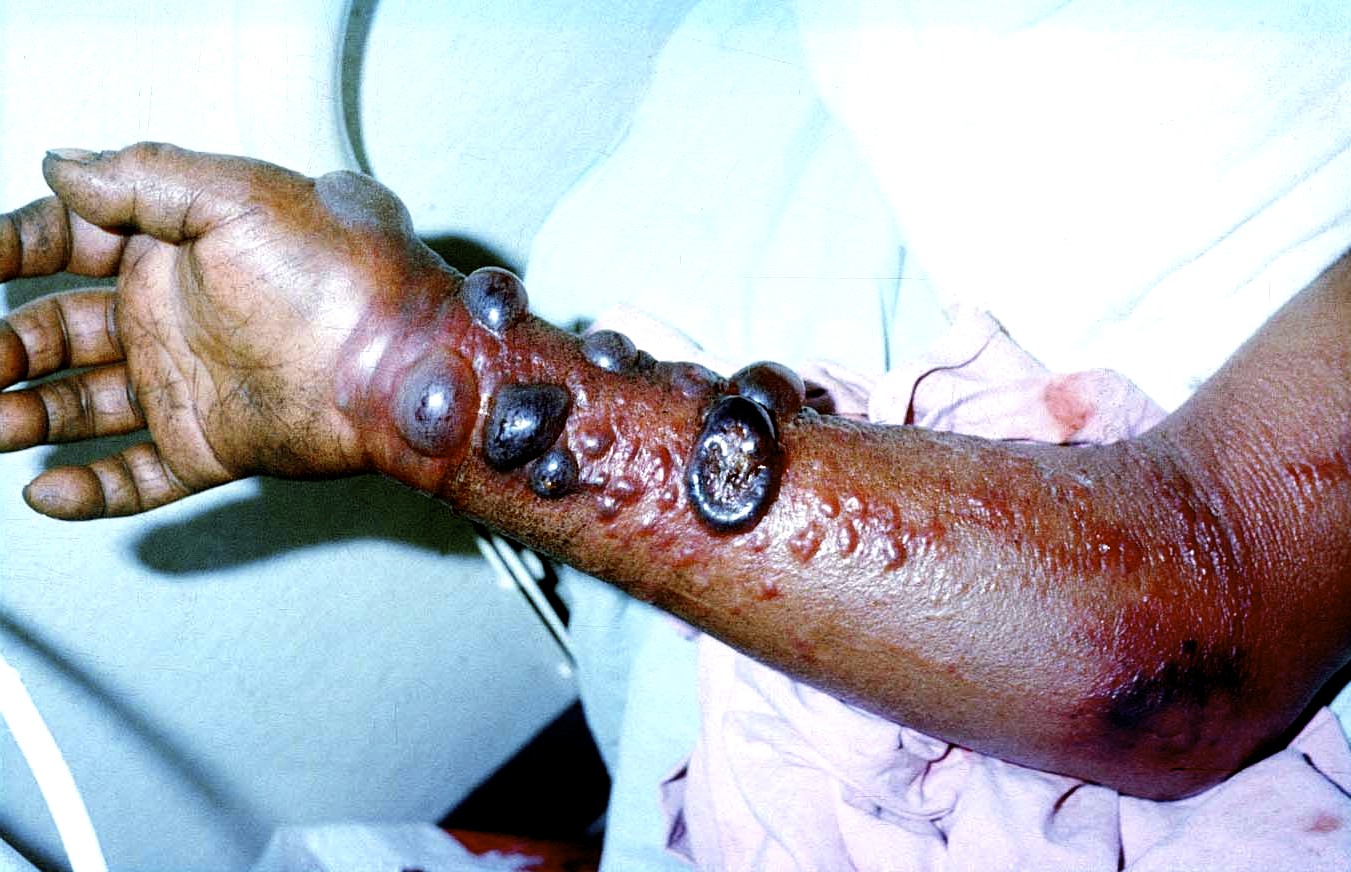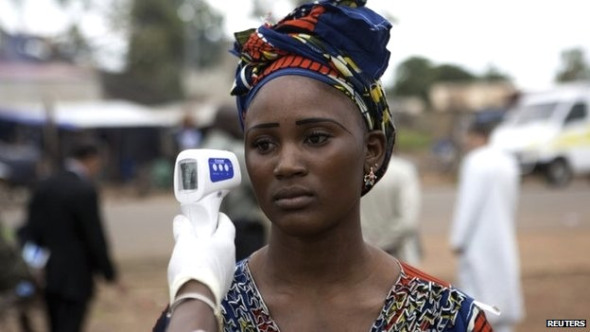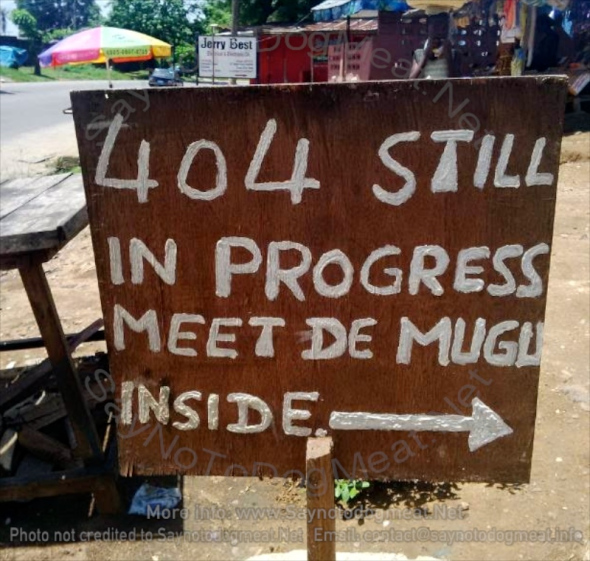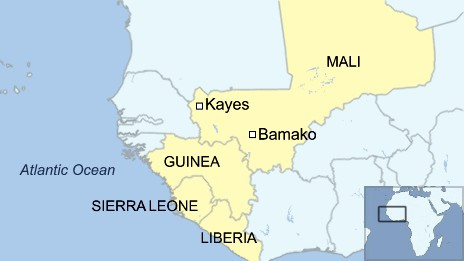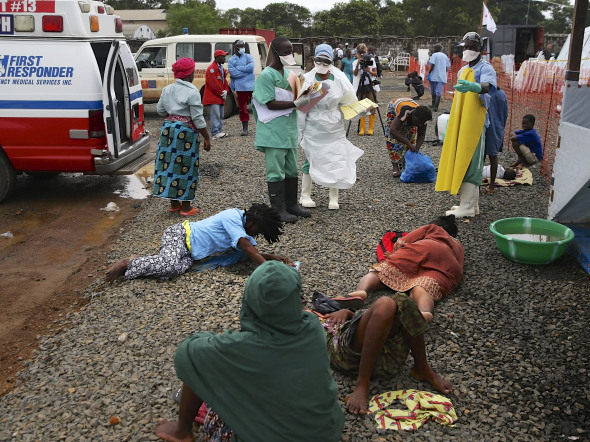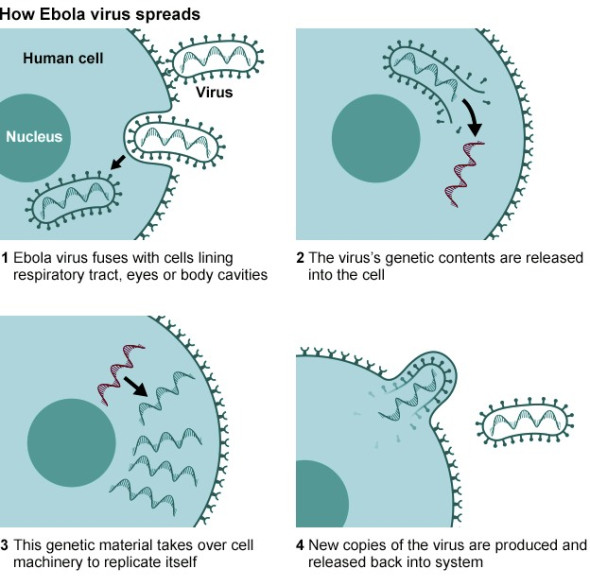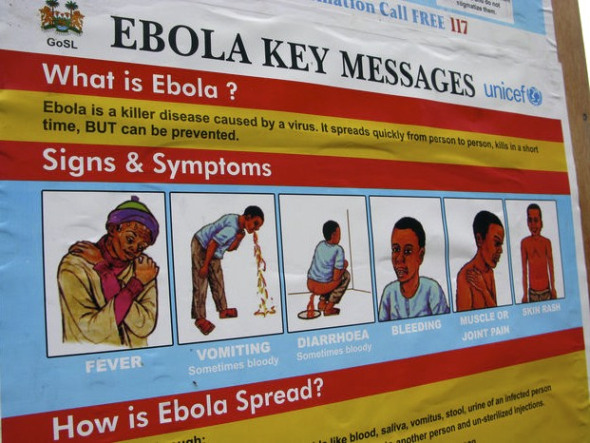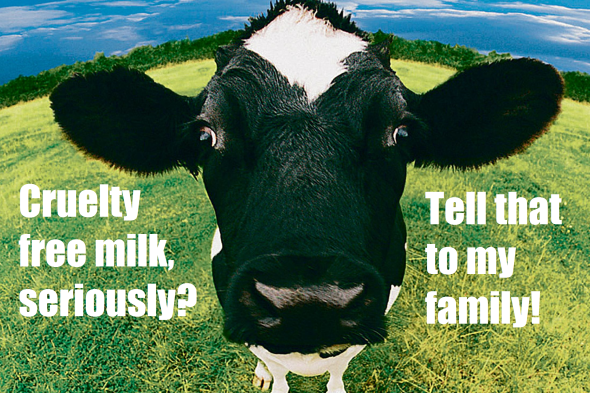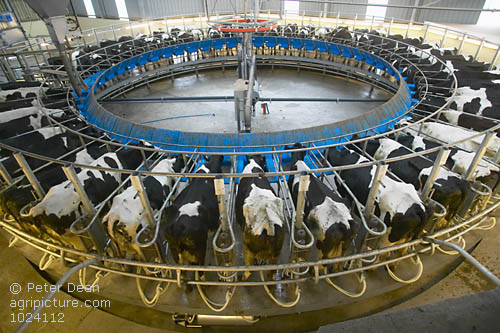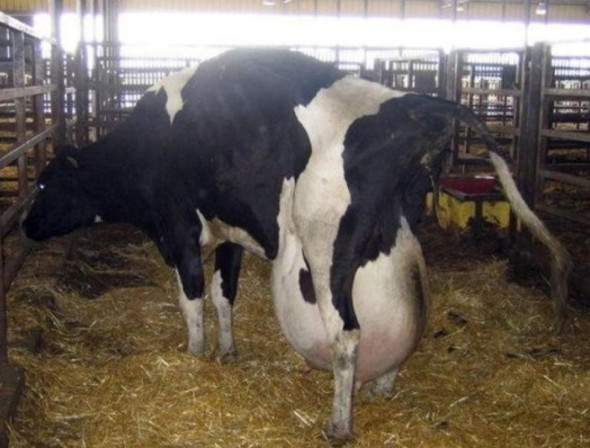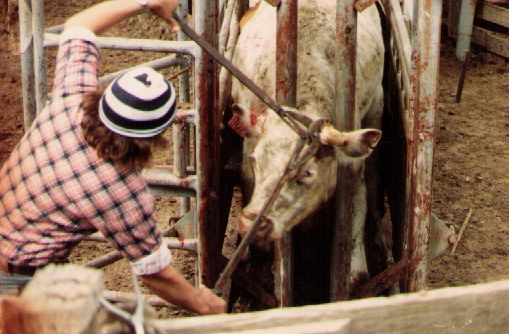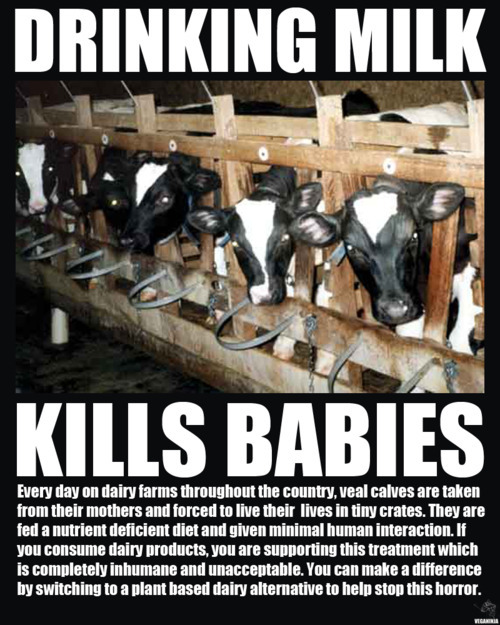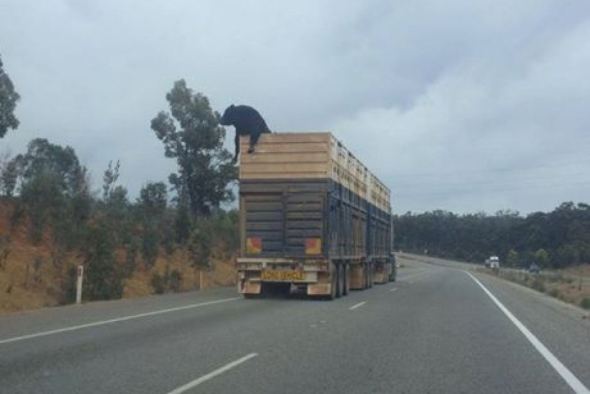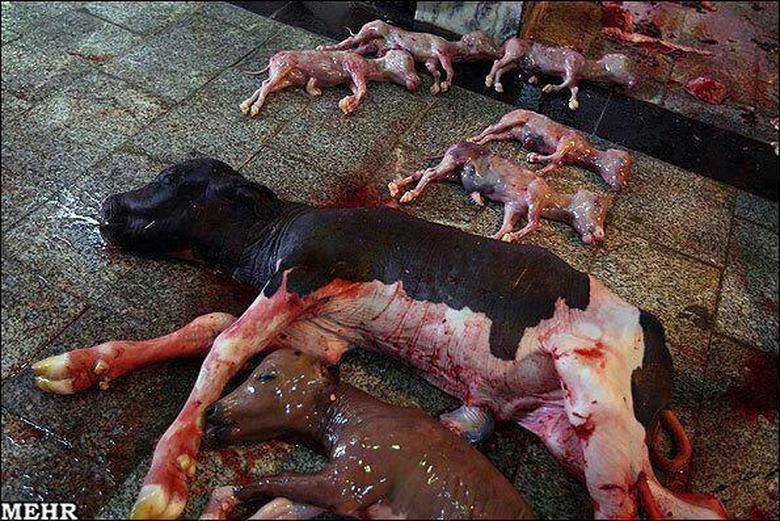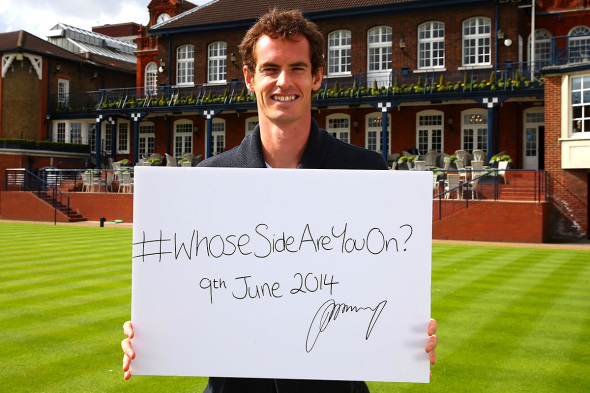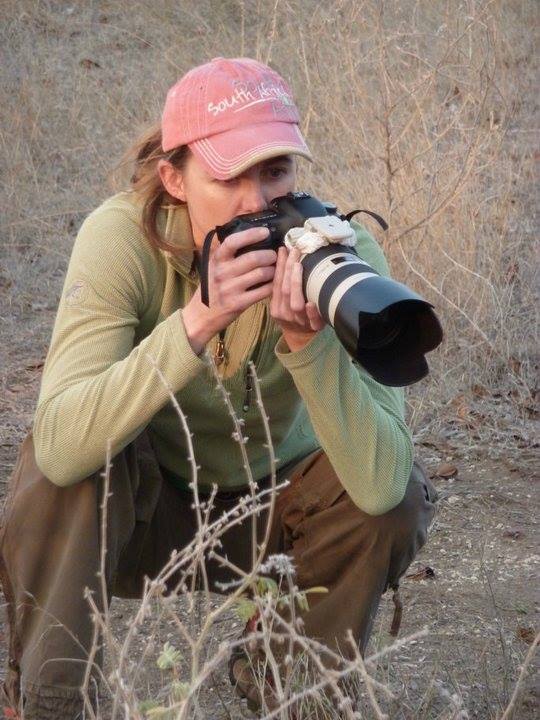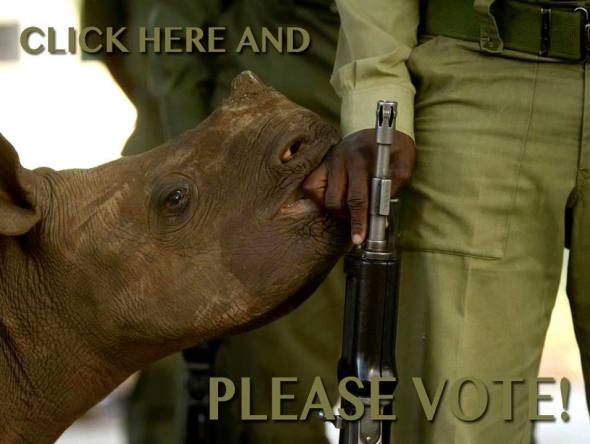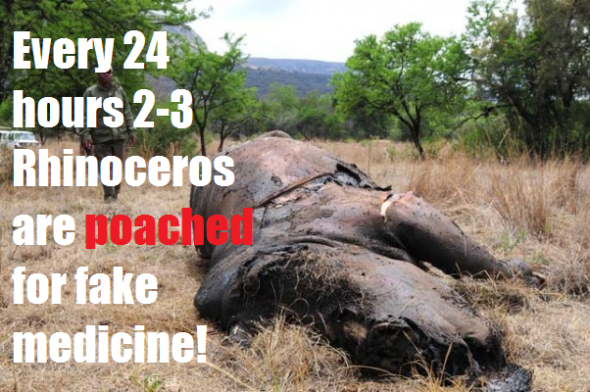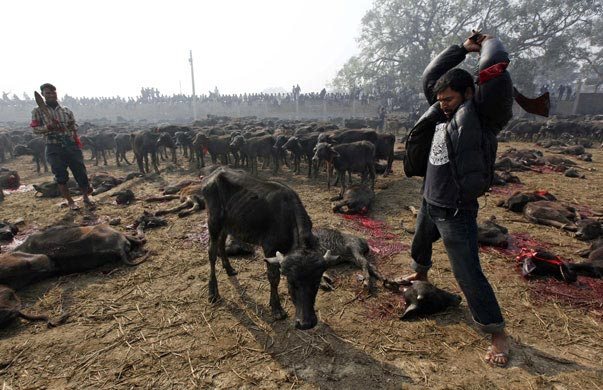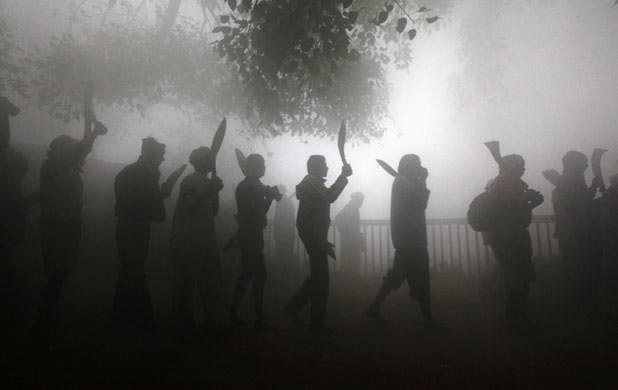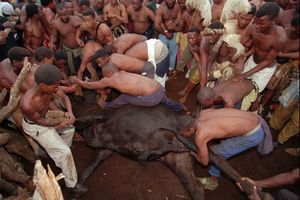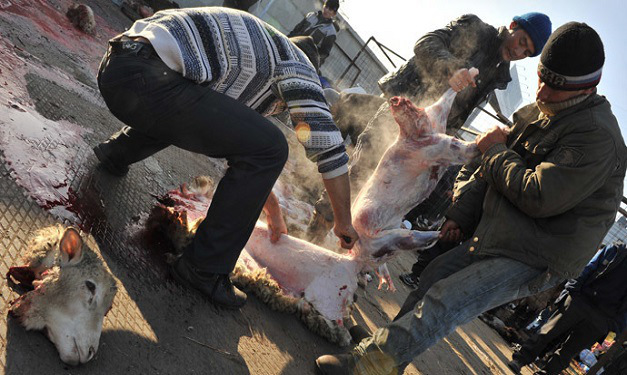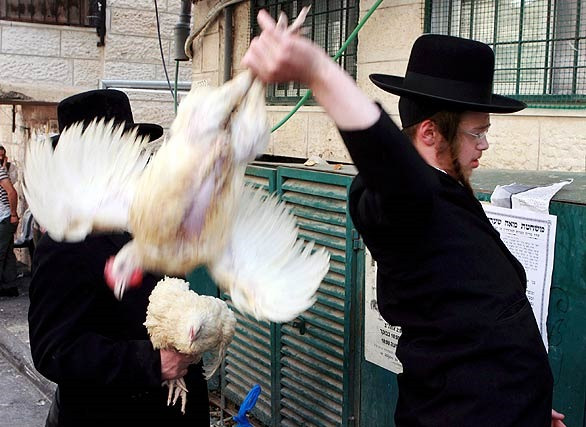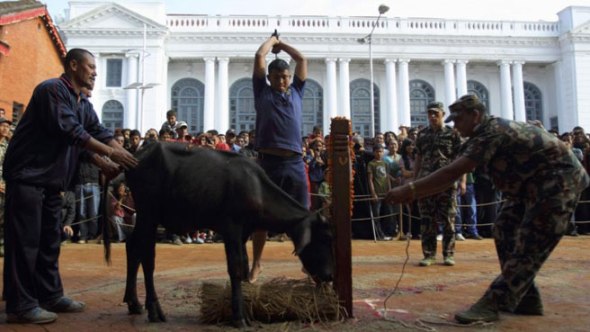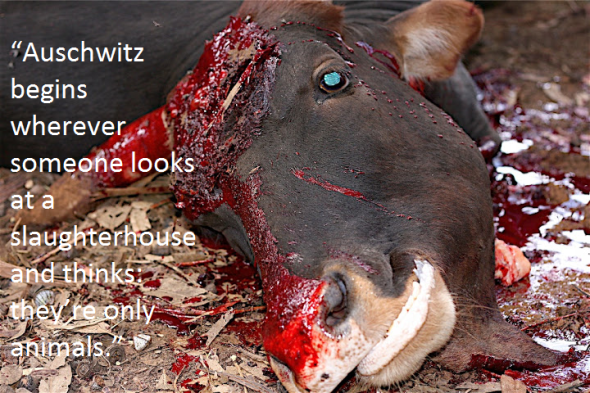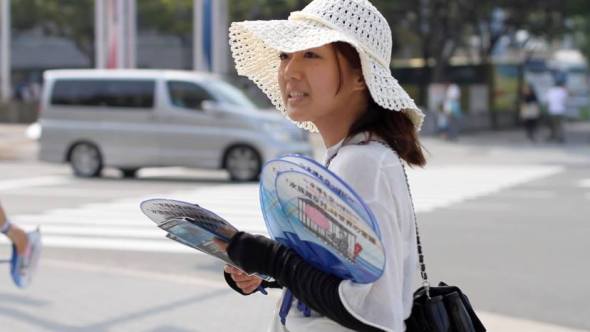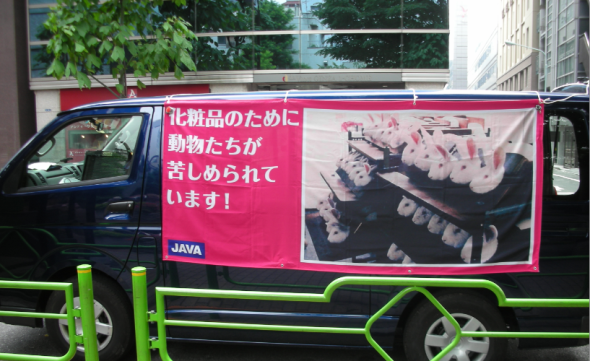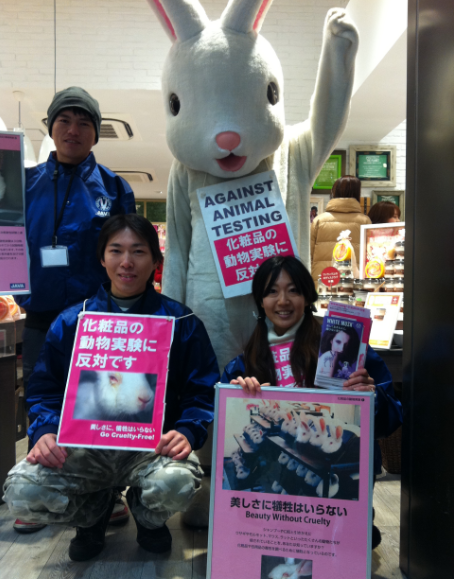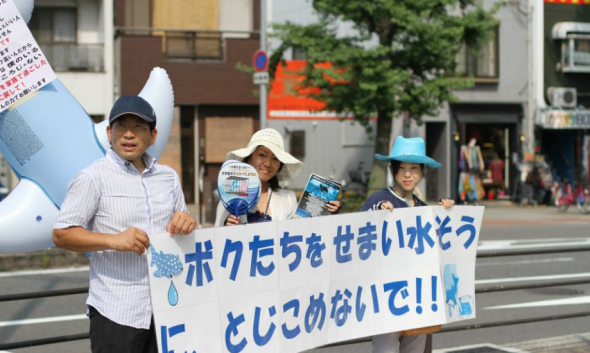Dog Meat Is Big Business in Nigeria
In a city where animal activists are almost invisible, dogs are crammed into small cages and trucked into Calabar from North Nigeria, to the waiting hands of dog butchers who hack them to death for dog meat.
Nigeria has a booming dog meat trade and the city of Calabar is one of it’s biggest hot-spots, where dog meat is openly sold on street corners and eaten by a broad spectrum of people who refer to it as ‘4o4.’ Chunks of dog meat can sell for as little as a hundred naira (less than a dollar), while a whole pot of dog meat can sell for as much as N14,000 or $87.00.
In Calabar, eating dog meat is seen a way of relaxing for some people and they can’t see whats wrong with it. However, people in Calabar who are against eating dog meat say “It is inhuman to eat up a pet, especially a dog which can become a family member.” Dog eaters reply “It is something as old as our culture. Our forefathers ate dog meat and we grew up learning to eat dog meat and by all standards, it is ok”.
Dog eaters far outnumber non-dog eaters in Calabar where its pet meat trade is lucrative and no matter how many dogs they kill, there’s always buyers waiting to eat them.
Weekends are the busiest time for slaughtering and eating dogs, especially Sundays when people in Calabar like to get together with family and loved ones and relax and eat dog meat.
Interestingly, women in Calabar eat just as much dog meat as men. Throughout Asia, dog meat is eaten mainly by men and women are shunned from eating it for a variety of reasons, mainly because men believe dog meat boots a man’s virility and is therefore dangerous for women to indulge in.
Dog meat used to be restricted to certain areas in Calabar and was mainly served with palm wine. Due to clever marketing, dog meat in Calabar is now a mainstream food which is served like any other restaurant food, with multiple choices of side dishes and beverages.
Just like in Asia a few decades ago, dog meat has gone from being eaten secretly to chic restaurant food that’s accepted everywhere, thanks to some clever marketing by dog traders, dog butchers and dog meat cooks.
In the same way Saynotodogmeat.Net are fighting Asia’s dog and cat meat trade, we will continue to fight Africa’s cruel pet meat trade too. We won’t stop until the dog and cat meat trade is brought to an END in Africa and Asia.
Thank you for reading,
Michele Brown.
GLOBAL MARCH
Saturday April 4th, 2015 Saynotodogmeat.Net is hosting a Global March for dogs and cats in the live meat trade. Please march with us, in your country. It will be an orderly and peaceful march but we need more ‘demonstration leaders.’ If you can help us, PLEASE EMAIL: CONTACT@SAYNOTODOGMEAT.INFO
Bring your family, children, pets and banners; we need as many people as possible, worldwide. Please mark your calendar and join our march. If you haven’t already done so, please click the box to let us know you are coming: https://www.facebook.com/events/294347744053559/
WE ARE NOW ACCEPTING DONATIONS
Saynotodogmeat.Net is now accepting donations: PLEASE MARK ALL DONATIONS “SAY NO TO DOG MEAT.NET” https://www.facebook.com/SayNoToDogMeat/app_117708921611213
No donation is too small and we are very appreciative of your help and support. Very soon we will be writing a full article outlining where donations will be used. You will receive an electronic receipt and we will too, which we will keep for historical data purposes. NO DONATION will be used to produce clothing with logos on, badges or banners. Donations are NOT for the directors. ALL MEMBERS FUND THEMSELVES.
PLEASE CONTINUE TO SIGN AND SHARE OUR SAYNOTODOGMEAT.NET PETITIONS; WHEN COMPLETED THEY’LL BE WILL BE HAND DELIVERED
PETITION FOR SOUTH KOREA
https://www.change.org/en-GB/petitions/president-geun-hye-park-take-dog-cat-meat-off-the-menu
PETITION FOR VIETNAM and THAILAND ANTI-SMUGGLING
PETITION FOR HEALTH MINISTER OF VIETNAM
https://www.causes.com/campaigns/71258-minister-of-public-health-thi-kim-tien
PETITION FOR NAGALAND
https://www.change.org/en-GB/petitions/additional-chief-secretary-take-dog-meat-of-nagaland-menu
PETITION TO BAN THE TRADE IN NIGERIA
https://www.change.org/en-GB/petitions/governor-of-lagos-hon-babatunde-fashola-ban-the-nigerian-dog-meat-trade-lagos
LETTER TO THE PRESIDENT OF THE PHILIPPINES
http://saynotodogmeat.net/2014/04/04/email-the-philippines-president-to-end-the-dog-meat-trade/
PLEASE SEND TO THE MUSLIM COUNCIL
http://saynotodogmeat.net/2014/01/17/open-email-to-the-muslim-council-of-great-britain/
PLEASE HELP THE PEOPLE OF TURKANA HERE
http://saynotodogmeat.net/2014/01/31/turkana-africa-emergency-aid-letter/
EMAIL THE GOVERNOR OF NIGERIA: New Address: info@nigeria.gov.ng
http://saynotodogmeat.net/2013/12/03/email-excellency-dr-honorable-alausa-excellency-honorable-babatunde-fashola/
JOIN THE WORLDWIDE GLOBAL EVENT HERE TODAY
PLEASE EMAIL US A.S.A.P FOR INFORMATION ON HOW YOU CAN HELP. SATURDAY 4TH APRIL 2015 – TIME TO MARCH FOR DOGS AND CATS IN THE MEAT TRADE.
JOIN HERE https://www.facebook.com/events/294347744053559/ SHARE EVERYWHERE WILDLY
SayNoToDogMeat.Net FACEBOOK and TWITTER
Email: contact@saynotodogmeat.info
#saynotodogmeat
ALL RIGHTS RESERVED
PLEASE CREDIT THE ORGANISATION WHEN SHARING
Africa: Live Dogs Exchanged For Palm Oil
Danwaki Dog Market is one of the main dog markets in Nigeria where live dogs are bartered in exchange for palm oil. Thursday mornings are the main day, at the Plateau State Dog Market, Danwaki.
On the day before (Wednesday), Kanke dog vendors get their stalls ready to attract as many customers as possible. Most Nigerian markets traders arrive at dawn, but for Danwaki, many traders travel through the night in lorries because by 4.00am the market is already bustling with activity. By 5.00am business is well underway.
Dog traders and buyers travel all the way from states like Cross Rivers, AkwaIbom, Benue, Nasarawa, Taraba, and many other southern states. Dog traders from neighbouring countries of Cameroun and Ivory Coast also frequent this dog market. Traders bring goods from their home states, in exchange for live dogs.
Palm oil from Calabar is known as “red gold,” giving Calabar traders an upper hand in doing business, as they exchange live dogs over for the equivalent value of palm oil.
A regualr dog buyer at Danwaki dog market, Mrs. Bassy Essien says she travels to the dog market twice a month to exchange palm oil for dogs because the business is “lucrative and rewarding,” the only risk involved is having to travel through the night all the way from Calabar to Jos in a lorry.”
She says once she gets the dogs back to Calabar they “sell like hot cakes” because their cooked as delicacies at local hot-beer joints like the Marina Beach spots, where politicians and foreign nationals sit outside in the cool of the evenings and enjoy eating dog meat.
She says:“With dog meat served together with hot local beer, an evening is made in Calabar!”
Another dog trader who calls himself Akpan said: “I have lived all my life in Calabar, but 12 years ago I started my dog business, that I discovered Marina Spot. When I see big politicians enjoy the delicacy dog meat I feel exceedingly fulfilled that I am a part of their joy.”
Dogs are bred in Plateau State for dog meat. [ NOTE: Breeding dogs for consumption means DOG FARMS.]
In Kanke Local Government Area it is considered a great honour to welcome a visitor with dog meat delicacy. Dog meat has now become a trend in most famous “joints,” even in Jos city. People joke that dogs which westerners call “man’s best friend” has now been renamed “man’s best taste.”
Does Dog Meat Have Powers To Cure?
Many people who eat dog meat falsely believe the meat has medicinal properties, including the false belief that dog meat improves a man’s sexual performance. This ties directly in with customers enjoying tough dog meat, which is brought about through cruel methods of slaughter which are done to deliberately flood the dog’s body with as much adrenaline s possible - making the meat as tough as possible. This is falsely believed to enhance a man’s libido. It will NOT.
Dog meat contains no magic, no power and no cures. If you’re impotent then seek professional medical help or see a sex therapist, but do NOT expect to get relief from eating dogs or cats.
Some people believe dog meat cures a lot of disease such as malaria, typhoid, dysentery in children, and even protection against witchcraft. It is falsely believed by some dog meat eaters that if they eat enough dog meat they will be protected from evil. There is no scientific evidence proving dog meat does anything except cure hunger.
Veterinarian Dr. Pam Musa believes dogs are inherently emotional and friendly to humanity and that slaughtering dogs for food is excessively cruel.
Thank you for reading,
Michele Brown.
GLOBAL MARCH
Saturday April 4th, 2015 Saynotodogmeat.Net is hosting a Global March for dogs and cats in the live meat trade. Please march with us, in your country. It will be an orderly and peaceful march but we need more ‘demonstration leaders.’ If you can help us, PLEASE EMAIL: CONTACT@SAYNOTODOGMEAT.INFO
Bring your family, children, pets and banners; we need as many people as possible, worldwide. Please mark your calendar and join our march. If you haven’t already done so, please click the box to let us know you are coming: https://www.facebook.com/events/294347744053559/
WE ARE NOW ACCEPTING DONATIONS
Saynotodogmeat.Net is now accepting donations: PLEASE MARK ALL DONATIONS “SAY NO TO DOG MEAT.NET” https://www.facebook.com/SayNoToDogMeat/app_117708921611213
No donation is too small and we are very appreciative of your help and support. Very soon we will be writing a full article outlining where donations will be used. You will receive an electronic receipt and we will too, which we will keep for historical data purposes. NO DONATION will be used to produce clothing with logos on, badges or banners. Donations are NOT for the directors. ALL MEMBERS FUND THEMSELVES.
PLEASE CONTINUE TO SIGN AND SHARE OUR SAYNOTODOGMEAT.NET PETITIONS; WHEN COMPLETED THEY’LL BE WILL BE HAND DELIVERED
PETITION FOR SOUTH KOREA
https://www.change.org/en-GB/petitions/president-geun-hye-park-take-dog-cat-meat-off-the-menu
PETITION FOR VIETNAM and THAILAND ANTI-SMUGGLING
PETITION FOR HEALTH MINISTER OF VIETNAM
https://www.causes.com/campaigns/71258-minister-of-public-health-thi-kim-tien
PETITION FOR NAGALAND
https://www.change.org/en-GB/petitions/additional-chief-secretary-take-dog-meat-of-nagaland-menu
PETITION TO BAN THE TRADE IN NIGERIA
https://www.change.org/en-GB/petitions/governor-of-lagos-hon-babatunde-fashola-ban-the-nigerian-dog-meat-trade-lagos
LETTER TO THE PRESIDENT OF THE PHILIPPINES
http://saynotodogmeat.net/2014/04/04/email-the-philippines-president-to-end-the-dog-meat-trade/
PLEASE SEND TO THE MUSLIM COUNCIL
http://saynotodogmeat.net/2014/01/17/open-email-to-the-muslim-council-of-great-britain/
PLEASE HELP THE PEOPLE OF TURKANA HERE
http://saynotodogmeat.net/2014/01/31/turkana-africa-emergency-aid-letter/
EMAIL THE GOVERNOR OF NIGERIA: New Address: info@nigeria.gov.ng
http://saynotodogmeat.net/2013/12/03/email-excellency-dr-honorable-alausa-excellency-honorable-babatunde-fashola/
JOIN THE WORLDWIDE GLOBAL EVENT HERE TODAY
PLEASE EMAIL US A.S.A.P FOR INFORMATION ON HOW YOU CAN HELP. SATURDAY 4TH APRIL 2015 – TIME TO MARCH FOR DOGS AND CATS IN THE MEAT TRADE.
JOIN HERE https://www.facebook.com/events/294347744053559/ SHARE EVERYWHERE WILDLY
SayNoToDogMeat.Net FACEBOOK and TWITTER
Email: contact@saynotodogmeat.info
#saynotodogmeat
ALL RIGHTS RESERVED
PLEASE CREDIT THE ORGANISATION WHEN SHARING
Mali, Africa: Dog Meat And Now Ebola
Ebola has now arrived in the country of Mali, West Africa, sparking further panic as the deadly virus creeps across the continent. The patient is a 2-year-old girl who was brought from neighbouring Guinea after her mother died of Ebola.
The girl showed symptoms, including a bleeding nose, while travelling on a public bus through several towns, as she travelled more than 1,000 km (600 miles) from Guinea through the capital, Bamako, to Kayes.
Bamako is a densely-packed city of 2.3 million people.
The girl’s blood sample tested positive in Fousseyni Daou hospital in the western town of Kayes,, where a further 43 people are being quarantined, including 10 health workers. Mali is now the sixth West African country to be fighting Ebola. The World Health Organisation says the disease has infected nearly 10,000 people and killed from half to 70 percent of them.
Dog Meat and Ebola
Dog meat is eaten in Mali and served at many “chop shops.” There is a link between Ebola and dog meat.
Dogs do not show any signs if infected with Ebola and dogs do NOT die from Ebola infections.
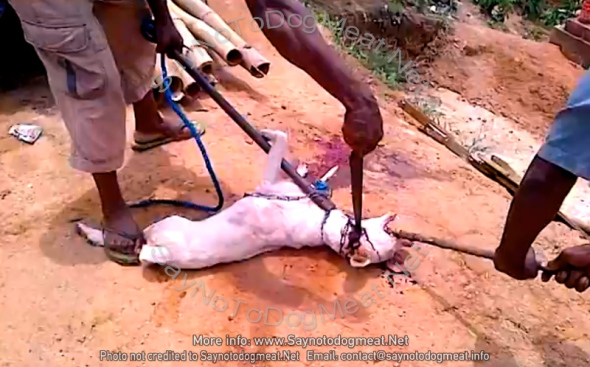
African dog butcher brutally slaughtering a dog for dog meat; the dog was in agony and fully conscious for several minutes.
Saynotodogmeat.Net Director Dr. Josa Depre advises that people refrain from eating dogs within Ebola infected zones. “Consuming dogs within an infected zone and knowing both dog can carry and show no signs is no different to playing Russian Roulette with one’s life,” says Dr. Depre.
Dogs in Africa are typically kept as pets to assist with hunting and are not “fed,” and therefore forced to scavenge food for themselves. In places like Liberia for example, dogs eat the carcass of Ebola infected animals and those same dogs are then captured by dog snatchers and sold for human consumption.
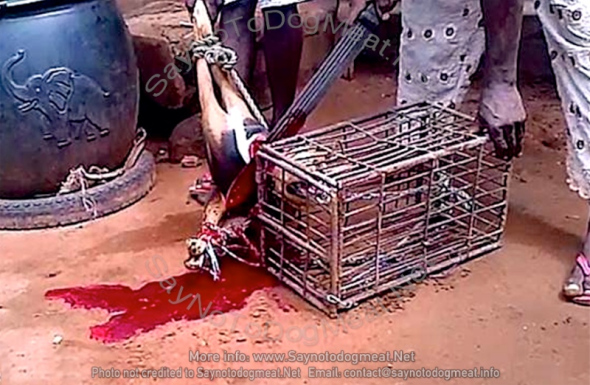
African dog butcher slowly slaughtering a dog, using a panga. Fully conscious, the dog was alive and in great agony for several minutes.
To date there have been no documented infections in felines, meaning that our domestic cats are probably safe from it.
Although dogs are susceptible to Ebola, the CDC concluded that “infected dogs are asymptomatic”, meaning that they do not develop symptoms.
During the early phase of their infection, however, they can spread the disease to humans and other animals through licking, biting, urine, and feces. However, the good news is that once the virus is cleared from the dog it is no longer contagious.”
Chop Shops In Mali
In San, Mali, there’s a restaurant in the old Bamabus terminal at the intersection turning south from the center of town. San is part of the Bobo ethnic area where dog meat is regularly served and eaten “as beef.” Restaurant reviews in Mali suggest that if you do not want to eat dog meat then you should stay away from ALL beef dishes, especially “chop shops” in certain areas, as a lot of the so-called beef is dog meat.
Guinea, which hasn’t closed any of its frontiers with six other nations, shares more than 800km of border with landlocked Mali to the east.
Ebola
Vaccines are not available until the first half of 2015, which is cold comfort for those who need vaccines immediately. Media statements such as “committed to ramping up production” by pharmaceutical companies are hollow words until the vaccines are actually produced and in use.
In America a New York doctor, Dr Craig Spencer who returned from Guinea on October 17th, has tested positive for Ebola, sparking terror amongst Americans after it was announced that the doctor had been travelling on the subway, possibly infecting other people. He is the first Ebola case diagnosed in New York, and the fourth in the US. On Tuesday he began to feel tired and developed a fever and diarrhoea on Thursday (BBC.)
The Ebola fatality rate can reach 90% - but current outbreak has mortality rate of about 70%. Incubation period is two to 21 days and there is no proven vaccine or cure. The current outbreak is the deadliest since Ebola was discovered in 1976.
An international team of scientists has been set up to determine the effectiveness of using the blood of Ebola survivors as a treatment. It is hoped the antibodies used by the immune system to fight Ebola can be transferred from a survivor to a patient.
How Not To Catch Ebola:
* Avoid direct contact with sick patients as the virus is spread through contaminated body fluids
* Wear protective cover for eyes
* Clothing and clinical waste should be incinerated and any medical equipment that needs to be kept should be decontaminated.
* People who recover from Ebola should abstain from sex or use condoms for three months
As with all the other Ebola infected areas, people in Mali are being urged to use soap when washing their hands. It is not customary to do this in Mali, but the World Health Organisation are stressing the importance of it.
All the African countries affected by Ebola are dog eating countries. There is a link between Ebola and dog meat.
DO NOT EAT DOG MEAT!
Thank you for reading,
Michele Brown.
GLOBAL MARCH
Saturday April 4th, 2015 Saynotodogmeat.Net is hosting a Global March for dogs and cats in the live meat trade. Please march with us, in your country. It will be an orderly and peaceful march but we need more ‘demonstration leaders.’ If you can help us, PLEASE EMAIL: CONTACT@SAYNOTODOGMEAT.INFO
Bring your family, children, pets and banners; we need as many people as possible, worldwide. Please mark your calendar and join our march. If you haven’t already done so, please click the box to let us know you are coming: https://www.facebook.com/events/294347744053559/
SAYNOTODOGMEAT.NEt NOW ACCEPTING DONATIONS
Saynotodogmeat.Net is now accepting donations: PLEASE MARK ALL DONATIONS “SAY NO TO DOG MEAT.NET” https://www.facebook.com/SayNoToDogMeat/app_117708921611213
No donation is too small and we are very appreciative of your help and support. Very soon we will be writing a full article outlining where donations will be used. You will receive an electronic receipt and we will too, which we will keep for historical data purposes. NO DONATION will be used to produce clothing with logos on, badges or banners. Donations are NOT for the directors. ALL MEMBERS FUND THEMSELVES.
PLEASE CONTINUE TO SIGN AND SHARE SAYNOTODOGMEAT.NET PETITIONS; WHEN COMPLETED THEY WILL BE HAND DELIVERED
PETITION FOR SOUTH KOREA
https://www.change.org/en-GB/petitions/president-geun-hye-park-take-dog-cat-meat-off-the-menu
PETITION FOR VIETNAM and THAILAND ANTI-SMUGGLING
PETITION FOR HEALTH MINISTER OF VIETNAM
https://www.causes.com/campaigns/71258-minister-of-public-health-thi-kim-tien
PETITION FOR NAGALAND
https://www.change.org/en-GB/petitions/additional-chief-secretary-take-dog-meat-of-nagaland-menu
PETITION TO BAN THE TRADE IN NIGERIA
https://www.change.org/en-GB/petitions/governor-of-lagos-hon-babatunde-fashola-ban-the-nigerian-dog-meat-trade-lagos
LETTER TO THE PRESIDENT OF THE PHILIPPINES
http://saynotodogmeat.net/2014/04/04/email-the-philippines-president-to-end-the-dog-meat-trade/
PLEASE SEND TO THE MUSLIM COUNCIL
http://saynotodogmeat.net/2014/01/17/open-email-to-the-muslim-council-of-great-britain/
PLEASE HELP THE PEOPLE OF TURKANA HERE
http://saynotodogmeat.net/2014/01/31/turkana-africa-emergency-aid-letter/
EMAIL THE GOVERNOR OF NIGERIA: New Address: info@nigeria.gov.ng
http://saynotodogmeat.net/2013/12/03/email-excellency-dr-honorable-alausa-excellency-honorable-babatunde-fashola/
JOIN THE WORLDWIDE GLOBAL EVENT HERE TODAY
PLEASE EMAIL US A.S.A.P FOR INFORMATION ON HOW YOU CAN HELP. SATURDAY 4TH APRIL 2015 – TIME TO MARCH FOR DOGS AND CATS IN THE MEAT TRADE.
JOIN HERE https://www.facebook.com/events/294347744053559/ SHARE EVERYWHERE WILDLY
Dairy Trade - Cruelty Free Milk?
Milk makes up quite a large part of the human diet for many of us. Milk can be purchased from major hypermarkets, markets and farms to local grocery stores in a wide variety of shiny white, blue or purple plastic, cardboard or glass containers. Pictures of children and families smiling happily with cows and farm animals or just comical cow drawings encouraging you to drink your milk is part and parcel of government advertising.
International Animal Rescue Foundation documents mostly on animal welfare and conservation issues locally and internationally of which we debated long and hard about publishing quite an extreme article that depicts just how the milk process works and the cruelty inflicted to cows just to provide a tasty white drink that is high in calcium, minerals and Melatonin a naturally sourced property. Synthetic and natural Melatonin aides sleep, relaxation and in synthetic pill form helps to reduce many childhood neurological and behavioral disorders such as Attention deficit hyperactivity disorder, Attention Deficit Disorder and Gilles de la Tourette syndrome being some of the common disorders that practitioners prescribe this medicine for and encourage children to drink more milk for.
For many years Animal Rights Activists have been battling dairy farmers, supermarkets, and slaughterhouses in vain to try and stop the cruelty that is inflicted to dairy cows. This can range from forced insemination straight after the female cow has given birth, the removal of calf after birth for the veal trade, transportation locally and globally down to the grotesque manners in which dairy cows are housed. Dairy trade may well look appealing to you the general public but what if we showed you the real side of the dairy trade. The horror inflicted daily just to provide you with a few liters of milk?
History;
Dairy farming is a class of agricultural enterprise for long-term production of milk, which is processed (on-site or at a dairy plant) for eventual sale of a dairy product. Dairy farming has been part of agriculture for thousands of years. Historically it has been one part of small, diverse farms. In the last century or so larger farms doing only dairy production have emerged. Large scale dairy farming is only viable where either a large amount of milk is required for production of more durable dairy products such as cheese, butter, etc. or there is a substantial market of people with cash to buy milk, but no cows of their own.
There are many different forms of dairy collection that range from hand milking, vacuum bucket milking, milking from pipelines, milking parlors, herringbone and parallel parlors, rotary parlors, automatic milker takeoff that can be very cruel to the milking herd and lastly fully automated robotic milking. All forms of milking are undertaken in a conveyor belt fashion that see’s hundreds of thousands of liters of milk produced a year every for the consumer.
Whilst this Wednesday’s article is focusing on “milk trade” we must also highlight the other practices that see’s many milking cows abused then later slaughtered for the human food chain. Butter - Butter’s origins go back about 10,000 years to the time when our ancestors first began domesticating animals. Today, butter in its many flavorful forms is the world’s most popular fat. As a versatile spread, a delicious enhancer for so many foods, and the essential ingredient for baking, butter’s simple goodness has no equal…
The first reference to butter in our written history was found on a 4,500-year-old limestone tablet illustrating how butter was made. It is generally believed the word butter originates from the bou-tyron, Greek for “cow cheese”, however it may have come from the language of cattle-herding Scythians.
Butter was used as food by ancient tribes of Asiatic India, as well as for burning in primitive lamps and smeared on skin to protect from the cold. In early times, unlike today, butter was so costly it was used in religious ceremonies. It still is today in India and Tibet.
In ancient Rome, butter was valued cosmetically. Not only was it used as a cream to make skin smooth, but Greeks and Romans massaged it into their hair to make it shine. Much esteemed for its perceived healing properties, butter was also used in poultices to fight skin infections and burns. The ancient Egyptians even valued it as a cure for eye problems.
During the T’ang Dynasty in China, clarified butter represented the ultimate development of the Buddha spirit. The ancient Irish, Scots, Norsemen and Finns loved and valued butter so much they were buried with barrels of it.
Christian missionaries travelling in central Siberia in 1253 mentioned a traditional fermented drink, kumyss, which was served with generous lumps of butter floating in it. In Northern Europe, in centuries past, butter was credited with helping to prevent kidney and bladder stones as well as eye maladies. (This was probably thanks to butter’s vitamin A content.)
Sailors in Elizabethan times were guaranteed 1/4 lb of butter a day in their rations, and it was an old English custom to present newlyweds with a pot of this creamy delight as a wish for fertility and prosperity.
It must also be noted that cows are not the only animal that produces milk. Humans, goat, sheep, Indian buffalo, camel, llama and even horses have and still are used for the production of milk. In the modern world most humans will consume mainly milk from cows and goats whereas in the still developing world sheep, goat, camel, buffalo and llama milk are used for milk production mainly due to price, difference in taste, allergies that derive from “cows milk”. Its not uncommon to see small or large families in Asia, Africa or even Great Britain with individual cows or goats that are milked to feed the family.
Cruelty;
The practice of dairy production in a factory farm environment has been criticized by animal welfare activists. Some of the ethical complaints regarding dairy production cited include how often the dairy cattle must remain pregnant, the separation of calves from their mothers, how dairy cattle are housed and environmental concerns regarding dairy production.
The production of milk requires that the cow be in lactation, which is a result of the cow having given birth to a calf. The cycle of insemination, pregnancy, parturition, and lactation, followed by a “dry” period of about two months of forty-five to fifty days, before calving which allows udder tissue to regenerate. A dry period that falls outside this time frames can result in decreased milk production in subsequent lactation. Dairy operations therefore include both the production of milk and the production of calves. Bull calves are either castrated and raised as steers for beef production or veal.
An important part of the dairy industry is the removal of the calves off the mother’s milk after the three days of needed colostrum, allowing for the collection of the milk produced. In order for this to take place, the calves are fed milk replacer, a substitute for the whole milk produced by the cow. Milk replacer is generally a powder, which comes in large bags, and is added to precise amounts of water, and then fed to the calf via bucket or bottle.
Milk replacers are classified by three categories: protein source, protein/fat (energy) levels, and medication or additives (e.g. vitamins and minerals). Proteins for the milk replacer come from different sources; the more favorable and more expensive all milk protein (e.g. whey protein- a bi product of the cheese industry) and alternative proteins including soy, animal plasma and wheat gluten. The ideal levels for fat and protein in milk replacer are 10-28% and 18-30%, respectively. The higher the energy levels (fat and protein), the less starter feed (feed which is given to young animals) the animal will consume. Weaning can take place when a calf is consuming at least two pounds of starter feed a day and has been on starter for at least three weeks. Milk replacer has climbed in cost US$15–20 a bag in recent years, so early weaning is economically crucial to effective calf management.
Rotary milking parlour. Spaces standings for 60 cows. capable of milking 350 cows in one hour.
Because of the danger of infection to humans, it is important to maintain the health of milk-producing cattle. Common ailments affecting dairy cows include infectious disease (e.g. mastitis, endometritis and digital dermatitis), metabolic disease (e.g. milk fever and ketosis) and injuries caused by their environment (e.g. hoof and hock lesions).
Lameness is commonly considered one of the most significant animal welfare issues for dairy cattle, and is best defined as any abnormality that causes an animal to change its gait. It can be caused by a number of sources, including infections of the hoof tissue (e.g. fungal infections that cause dermatitis) and physical damage causing bruising or lesions (e.g. ulcers or hemorrhage of the hoof). Housing and management features common in modern dairy farms (such as concrete barn floors, limited access to pasture and suboptimal bed-stall design) have been identified as contributing risk factors to infections and injuries.
Exposed abuse;
Over the past decade farmers have been complaining that animal and welfare activists have accounted for mass loss of farm production through direct and indirect actions against cattle farmers. Farmers have had to resort to drastic security measures to secure their farms thus ensuring what happens on the inside is not portrayed on the outside. Ag-Gag laws within the United States have been drafted up by government that is aimed at “prosecuting those that expose abuse on farms”. Ag Gag was devised in a way to protect American interests.
Anti-whistleblower bills (“ag-gag” bills) seek to criminalize whistleblowing on factory farms, keeping Americans in the dark about where their food is coming from. Whistleblowing employees have played a vital role in exposing animal abuse, unsafe working conditions, and environmental problems on industrial farms.
Instead of working to prevent these abuses from occuring, the agribusiness industry has been working to prevent people from finding out about such problems by supporting anti-whistleblower bills.
Anti-whistleblower bills effectively block anyone (within US states) from exposing animal cruelty, food-safety issues, poor working conditions, and more in factory farms. These bills can also suppress investigations into cruel horse soring, mistreatment of animals in laboratories, and other abuses. These bills could do this by:
- Banning taking a photo or video of a factory farm without permission,
- Essentially making it a crime for an investigator to get work at a factory farm, or
- Requiring mandatory reporting with impossibly short timelines so that no pattern of abuse can be documented.
What is Big Ag’s big secret?
These anti-whistleblower bills raise the question, “What does animal agriculture have to hide?” By criminalizing whistleblowing, these bills would make important undercover investigations impossible—investigations like:
- The HSUS exposé of calf abuse at a Vermont slaughter plant that led to the plant’s closure and a felony criminal conviction
- The HSUS investigation of a cow slaughter plant in California, which prompted the largest meat recall in U.S. history and criminal convictions, too
- The HSUS investigation of Wyoming Premium Farms, which documented rampant animal abuse and brought charges of criminal animal cruelty for nine workers
Within the United States covert welfare officers have already fallen foul of such Ag-Gagging laws. While the United States believes this is to protect the interests of America and the overall economy such cruelty practices (see video below) must continue to be exposed so that you the consumer are aware of what you are buying, placing your money into, and consuming. Regardless of whether one is damaging the economy by highlighting such abuses one must continue to ask yourself, would you allow a human to be treated in this manner? Cow, horse, pig, duck, or any animal (we are all living-beings) we all feel pain and suffering so no animal no living being should be subjected to such abuses and no enforcement officers should ever be silenced.
There is a great deal of variation in the pattern of dairy production worldwide. Many countries which are large producers consume most of this internally, while others (in particular New Zealand), export a large percentage of their production. Internal consumption is often in the form of liquid milk, while the bulk of international trade is in processed dairy products such as milk powder.
Injury and Illness within the Dairy trade;
There are many injuries and illness that have been documented within the dairy agricultural trade whether it be deliberate or from poor animal husbandry disease and poor husbandry is rife throughout the entire farming industry. the more people fund this trade the longer these abuses continue.
Mastitis is the inflammation of the mammary gland and udder tissue, and is a major endemic disease of dairy cattle. It usually occurs as an immune response to bacterial invasion of the teat canal by variety of bacterial sources present on the farm, and can also occur as a result of chemical, mechanical, or thermal injury to the cow’s udder.
Milk-secreting tissues and various ducts throughout the udder can be damaged by bacterial toxins, and sometimes permanent damage to the udder occurs. Severe acute cases can be fatal, but even in cows that recover there may be consequences for the rest of the lactation and subsequent lactations.
The illness is in most respects a very complex disease, affected by a variety of factors: it can be present in a herd subclinically, where few, if any, symptoms are present in most cows. Practices such as close attention to milking hygiene, the culling of chronically-infected cows, good housing management and effective dairy cattle nutrition to promote good cow health are essential in helping to control herd mastitis levels.
Mastitis is most often transmitted by contact with the milking machine, and through contaminated hands or other materials, in housing, bedding and other equipment. During the 1960s, a five-point plan was devised by the National Institute for Research into Dairying, aimed at providing a strategy for the reduction and control of mastitis at farm level, which in adapted form is still followed today.
Mastitis treatment and control is one of the largest costs to the dairy industry in the UK, and is also a significant factor in dairy cow welfare. Mastitis can seen in the picture below.
You may or may not have seen the many videos of dairy cows that are hoisted up by large four by four forklifts that have gone lame. Sadly this is an all to common site within the the Agricultural trade. Cows that are pushed beyond their limitations can acquire some of the most sickening of diseases and injuries. Even with these injuries and illness present “some” of these cows are then fed back into the human and animal food chain. The steak that you ate last night that said “farm assured” or “100% welfare” could very well have come from any farm locally sourced or internationally that has allowed diseased stock into the food chain. Can you honestly be sure that the beef stew you have eaten was not a lame diseased cow? The glass of milk you are drinking has not come from a cow that has suffered repeated mastitis infectious? The answer is no , unless of course you farm, kill, and slaughter yourself.
The most common injuries to dairy cows are bruising or ulcers on the soles of their hooves and sores on their legs caused by rubbing against concrete bed stalls. These injuries cause animals to become “lame,” which means they have difficulty walking. Pasture or other soft, dry surfaces can help reduce the risk of these injuries. Lameness is one of the most serious welfare concerns for dairy cows because it is painful, and unfortunately it is also very common. Research demonstrates that about 25% of dairy cows at peak lactation in BC are clinically lame – on some farms this number can escalate to over 50%. Animal welfare scientists are working hard to find ways to detect lame cows early so that they can be treated. They are also working with farmers, veterinarians and other professionals to find new ways to design and manage dairy barns to prevent cows from becoming lame in the first place.
Transition Period Diseases;
Dairy cows give birth every year in order to continue producing milk. The transition from pregnancy through giving birth to producing milk is full of changes and challenges, and has been aptly named “the transition period”. Not surprisingly, some dairy cows cannot cope with all of these challenges and illness is common during the transition period. This vulnerability to disease is largely due to the incredible energy demand that lactation places on their bodies. As much as 30-50% of cows become sick with metabolic or infectious disease during this period. For this reason, it is critical to ensure that cows have good access to high-quality feed at this time. Canada’s Code of Practice for the Care and Handling of Dairy Cattle recommends that 2 feet of space be provided per cow at the feeder, and ideally an entire group of cows should be able to eat at the same time.
Tail docking is also a very cruel and painful process within dairy cow farming. Farmers will often tell you that docking does not take place or if it does cows will not feel a thing. This is yet another lie and myth of the agricultural business. Dairy cows give birth every year in order to continue producing milk. The transition from pregnancy through giving birth to producing milk is full of changes and challenges, and has been aptly named “the transition period”. Not surprisingly, some dairy cows cannot cope with all of these challenges and illness is common during the transition period. This vulnerability to disease is largely due to the incredible energy demand that lactation places on their bodies. As much as 30-50% of cows become sick with metabolic or infectious disease during this period. For this reason, it is critical to ensure that cows have good access to high-quality feed at this time. Canada’s Code of Practice for the Care and Handling of Dairy Cattle recommends that 2 feet of space be provided per cow at the feeder, and ideally an entire group of cows should be able to eat at the same time.
Female dairy calves are dehorned in order to prevent injury to each other or to people later in life. Using a procedure called “disbudding,” the small emerging horn bud is prevented from growing by burning the tissue with a hot iron or a caustic chemical paste. Research has shown that pain caused by these procedures can be eliminated by giving calves a combination of a sedative, local anesthetic, and analgesic. In Canada, it is now required that at least some kind of pain control is used when dehorning or disbudding according to the Code of Practice for the Care and Handling of Dairy Cattle.
While “Code of Practices” may at times be adhered too it is unfortunate that many cows will suffer from serious pain and infections caused by de-horning, docking. Picture below shows a typical de-horning practice.
Veal industry;
Veal is a by-product of the very cruel dairy industry that still many people are none-the-wiser-about. Many dairy consumers still do not understand that for a cow to produce milk she has to gestate. Once mother has produced her calf the veal the calf is cruelly removed and then held in a veal crate (pictured below)..
Cows produce milk for the same reason why humans and other mammals do: to nourish their young. But the millions of cows who live on U.S. dairy farms are forced into a vicious cycle of continuous pregnancy so that they will produce milk for human consumption. Their female calves are slaughtered immediately or used to replace their mothers in the dairy herd, and many male calves end up in veal crates―a fate characterized by confinement, darkness, malnutrition, and slaughter.
Without human intervention, calves suckle from their mothers for nearly a year. One veterinary study revealed that “during natural weaning there is never complete and abrupt abandonment of the calf by the cow. In fact, the … cow and calf will maintain a lifelong relationship of social contact and companionship ….” Another study found that a cow and her calf can develop a “strong maternal bond” in as little as five minutes. But calves born on dairy farms are taken from their mothers on the same day that they are born and fed milk replacers, including cattle blood, so that humans can have the milk instead. This forced separation causes cows and calves great distress, and cows have been known to escape enclosures and travel for miles to reunite with their young.
Calves raised for veal are forced to spend their short lives in individual crates that are no more than 30 inches wide and 72 inches long. These crates are designed to prohibit exercise and normal muscle growth in order to produce tender “gourmet” veal. The calves are fed a milk substitute that is purposely low in iron so that they will become anemic and their flesh will stay pale.
Because of these extremely unhealthy living conditions, calves raised for veal are susceptible to a long list of diseases, including chronic pneumonia and diarrhea. A study published in the Journal of Animal Science found that calves who were kept in “smaller housing units” had difficulty keeping themselves clean and had trouble “extending their front legs and changing from a lying to a standing position,” which resulted in joint swelling. It was also determined that stereotypical forms of stress behaviors, such as tongue rolling and “sham-chewing” (the act of chewing without food in the mouth), increase when smaller pens were used and as calves got older.
After enduring 12 to 23 weeks in these conditions, these young animals—many of whom can barely walk because of sickness or muscle atrophy—are crowded into metal trucks for transport to the slaughterhouse. On these trucks, they are trampled and suffer from temperature extremes and lack of food, water, and veterinary care. A glimpse into the shocking veal trade can be seen here in video below that may be upsetting to some and disturbing to others.
Transportation;
Every year millions of cows are transported worldwide just for the dairy and beef trade. There have been many occasions when cows have been poorly mistreated, left on the back of long wagons in freezing temperatures or within heatwaves that it sends the cows insane to the point they collapse form either heat exhaustion, dehydration or hypothermia. One shocking image that was captured within Australia this month saw a cow that appears to be a dairy cow trying to escape from the back of a long wagon. The image caused outrage yet has done little to increase welfare standards within the farming, slaughter and transportation trade of livestock. (Picture can be seen below).
Livestock are transported by land (road or rail), sea and air. Livestock are most often transported to achieve translocation immediately prior to harvest but also to move them to sources of less expensive or more abundant feed supplies (for growth or fattening), because of changes in ownership, for breeding purposes, to enter intensive production units or for exhibition in shows or contests. Tarrant and Grandin (2000) characterized the transport process as: (a) Beginning with assembly and including loading, confinement with and without motion, unloading, and penning in a new and unfamiliar environment. (b) During transport, animals are exposed to environmental stresses including heat, cold, humidity, noise, motion and social regrouping., (c) Transportation by its nature is an unfamiliar and threatening event in the life of an animal. (d) Transportation involves a series of handling and confinement situations which are unavoidably stressful and can lead to distress, injury or even death of the animal unless properly planned and carried out. (e) Transportation often coincides with a change in ownership whereby responsibility for the animal’s welfare may be compromised.
Concluding;
An article published by the British cattle Veterinary Association reveals that 150.000 000 cattle are pregnant when sent to The slaughterhouse every year. At least 40.000 of these cattle have been found in the last stages of pregnancy. 90 percent of cows are dairy cows and the majority of the farmers do not they realize that they are pregnant. In the survey avc, 50,9 % of farmers thought the cow was not pregnant, and 27,3 % said that they did not know. This kind of shows just how unprofessional farmers are and the lack of expertise too that is failing many dairy cows and other farm animals.
The infertility is quoted as the reason most common to the slaughter of an animal, followed by the mastitis (an inflammation painful of the ubres very common in The dairy cows) and then the old age. Some cows, they are sending to the slaughterhouse thinking that they are infertile, when in reality they are pregnant. Animals are sent to the market one farmer stated are heavy before I kill them. The farmer is compensated per kilo if the animal is found to be pregnant. You can see just what we mean by poor husbandry, lack of knowledge, and failings within the picture below. The cow and many more sent to slaughter was in fact pregnant yet the farmer nor the slaughter-man knew until the cow was finally slaughtered.
Gabriele Meurer MRCVS, an ex surgeon vet officer in abattoirs in the UK, says: “Sometimes, when these creatures are hanging in the line to be slaughtered you can see the calves kicking inside of their mothers. I, like a vet, I just had to look at it, do not do nothing and stay silent. It broke my heart and I felt like a criminal, after witnessing this so many times I then left the practice horrified and moved by what I witnessed on a daily basis”.
If this article has somewhat concerned you and you wish to try an alternative to milk then do not be afraid there are other milks out there that are more healthy, contain few if any agricultural medicines used in the farming industry and are much kinder to ones tummy too. We’ve listed them below for your information.
High in fat and with a carbon footprint to match, cow’s milk is neither the greenest or healthiest milk available. So what are the alternatives? Here are some of the best From greenhouse gas emissions to antibiotics, the problems associated with cow’s milk are legion. According to Tim Lang, Food Commissioner at the Sustainable Development Commission (SDC): ‘The heavy footprint of the meat and dairy industry means it’s right to prioritise exploring how, not just whether, over-consuming societies like the UK can reduce their meat and dairy consumption.’ Then there are the health issues associated with the white stuff, which range from dairy intolerance through to high cholesterol. Loaded with calories and heavy on the saturated fat, cow’s milk certainly isn’t the diet conscious choice for putting in your cuppa. Milk does have some health benefits though – calcium for example – but that mineral aside, there are better choices that are both low in fat and good for the planet. Here’s our pick of the best alternatives to cow’s milk.
Soya Milk - we rate this a 7/10
Packed with protein and fibre, benefits of soya milk include the presence of cancer-fighting isoflavones, minimal saturated fat and the absence of galactose, which means that it can replace breast milk for galactosaemic children. It’s also safe for the lactose intolerant and anyone with a milk allergy. Because it comes from plants, there are no animal welfare issues associated with it and the growing soya plants absorb rather emit carbon – the direct opposite of dairy cows. There are some downsides though, chiefly that its sugar content can be high, particularly in the flavoured versions. Other issues include the increasing amount of land being used to farm it, which is leading to deforestation in some countries. However, its overall impact is still much less than that of cow’s milk, particularly when you choose an organic version.
Almond Milk - we rate this a 9/10
Almond milk is good source of magnesium, which helps to break down food can help with the function of the parathyroid glands, thus helping improve the health of your bones. It’s also loaded with manganese, selenium and Vitamin E. Vitamin E is an antioxidant that protects the cell membranes. Selenium is good for our immune system; it helps in reproduction, and in the metabolism of thyroid. It also prevents cell damage and tissue damage. Almond milk is also a good source of unsaturated fat, protein, flavonoids and potassium, and has less sugar than soya milk. Like soya milk though, it has a smaller carbon footprint by virtue of being derived from a plant source rather than a methane producing animal one. However, it doesn’t taste like cows milk by any stretch of the imagination, so it takes some getting used to if you’re looking for a true milk substitute. It’s also significantly more expensive as almonds, a hard-to-grow crop, are the main ingredient.
Rice Milk - we rate this a 9/10
Rice milk is the most hypoallergenic of all the milk substitutes and is extremely nutritious. It’s also the least fattening of all the milk alternatives with only one gram of unsaturated fat per cup. There are also plenty of heart healthy nutrients in rice milk. The unsaturated fat comes from rice bran oil, which can help lower your blood cholesterol. Niacin and vitamin B6 are also good for this while the high magnesium content helps to control your blood pressure. Iron and copper increases your red blood cell production, giving you better oxygenated blood and more vitality. On the downside, since rice is highly starchy, so is rice milk. One cup of rice milk contains 33 grams of sugary carbohydrates, three to four times the amount in milk or soya milk. If you have diabetes, rice milk can cause a sudden sugar overload. It also has a very low protein count compared to cow’s milk and soya, and the calcium content is also minimal, so choose the fortified product instead.
Oat Milk - we rate this a 10/10
Like many plant milks, oat milk is cholesterol and lactose free, and also contains high levels of antioxidant vitamin E. It also contains folic acid, which is essential for most bodily functions and is needed to synthesise and repair DNA, produce healthy red blood cells and prevent anaemia. Thanks to its plant source, oat milk is usually tolerated by people with multiple allergies, and is also a good source of phytochemicals; naturally occurring chemicals in plants that help fight diseases such as cancer, heart disease and stroke. The main argument against oat milk is that it, like rice milk, is high in sugar and doesn’t have the calcium and protein content of cow’s milk. Since it’s derived from a cereal crop, it’s also no good for people who are allergic to gluten, and has a distinctive, oaty flavour, which doesn’t appeal to everyone. It’s also fairly difficult to source and is usually only available in health food shops.
Hemp Milk - we rate this a 7/10
A good alternative for anyone with soya and nut allergies, hemp milk is also cholesterol and lactose free, low in saturated fats and rich in healthy omega fatty acids. It’s also an excellent source of protein and tastes creamier and nuttier than soya milk or rice milk, and also tends to be a bit thicker than other plant-based milks. Like other plant milks though, it lacks calcium and isn’t as widely available as soya, rice and goat’s milk.
Cashew Nut Milk - we rate this a 8/10
According to the George Mateijan Foundation, a quarter of a cup of cashews supplies almost 38 percent of the recommended daily intake copper, which is involved in many important bodily functions such as developing bone and connective tissue, producing melanin, and iron absorbtion. Cashews are a great source of magnesium like calcium, magnesium is also extremely important in keeping our bones strong and healthy, and, compared to other nuts, cashews have a lower overall fat content. As with the other nut-based milks you can also make cashew milk at home
Coconut Milk - we rate this a 10/10
Coconut milk is a very creamy, dairy-free alternative for those who are lactose intolerant or allergic to animal milk. Those who subscribe to the low-carb lifestyle often prize coconut milk for it’s minimal starch content. A vegan drink, it is also soya-free, gluten-free, cholesterol-free and nut-free while its fat content is considered to a ‘good fat’, easily metabolised by the body and quickly turned into energy rather than being stored as fat. Coconut milk is also rich in lauric acid, a substance also found in human milk, which researchers have shown have anti-viral and anti-bacterial properties. Unlike other nut or plant milks, the saturated fat content of coconut milk is significant at five grams per serving, so drink it in moderation. It can solidify and separate when refrigerated, depending on the brand, so if you like a cold glass of milk, it’s an inconvenient choice since you have to stir it and let it warm up to room temperature in order to drink it. Some brands also have a strong flavour that can be a bit overpowering.
If ever you are unsure please contact our vegan and vegetarian society here.
You can also watch the film Earthlings here and educate yourself on the horrors of all farming and animal abuse. Not suitable for people under the age of 12 years.
Rhino War and Photography
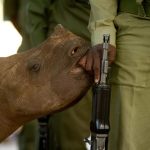
Rhino poaching within Africa has reached yet again an all time new high with a total of some 543 Rhinoceros poached dead for Traditional Chinese Medicine. Even with vast awareness campaigns, increased border patrols, upping Anti Poaching and funding the killing continues. Will it ever end? how long is a piece of string?
From the 30th June 2014 the (DEA) Department Of Environmental Affairs (South Africa) issued their Rhino poaching statistics of which was then 496. Since then a further 50+ have been bludgeoned leaving many people feeling hopeless, let down by their government, and debating on whether it is really a practical choice to support a trade in Rhino horn.
Poaching statistics for 2014 have again beaten records for the years 2010-2011. For both years, poaching statistics for 2010 were 333 poached Rhino and for the year 2011 we saw a total kill rate of 448. Poaching statistics for 2012 look as if they are most likely going to be beaten by this years June-July figures too that saw a total of 668 Rhinoceros poached in cold blood.
On a positive note arrest rates are also allegedly increasing from last year that saw a sky-rocketing 1003 Rhinoceros poached. Increased arrest rates doesn’t necessarily mean we are winning the battle, it merely shows that more and more poachers are encroaching from over the border into South Africa. 2010 saw a total of 165 poachers arrested, 2011 - 232, then in 2012 a total of 267 poachers were arrested, 2013 arrest rates shot up of which a total of 343 Rhino poachers were arrested. For June-July 2014 a total (estimate) arrest rate sees some 141 arrested. So 1148 poachers have been arrested yet we have only seen a handful of these poachers actually charged, brought to justice and convicted.
Its hard to actually believe too that Rhino horn made up of almost the same identical properties as human hair, finger nails, horse hoof, and parrot beak is selling illegally on the black market for a whopping $65,000kg whereas gold sells for a mere $43,000 kg and cocaine illegally trading at some $20,000 kg. Demand is not decreasing and while demand increases so will poaching and as explained there seems to be no end of the onslaught insight.
A powder made from the horns is prescribed in traditional Chinese medicine to cure fever and convulsions, but the substance is now used as a status symbol and a very expensive way for affluent Vietnamese to cure hangovers or, supposedly, to get high—even though the horns are composed of the common material keratin and have about the same psychoactive effects as snorting a fingernail clipping.
By weight, the horns go for anywhere from $60,000 to $100,000 per kilogram—single horns are about 3.5 kg, on average—making the substance significantly more pricey than other ubiquitous status symbols and intoxicants. Indian Rhino horns are still the most sought after and pricer too. International Animal Rescue Foundation Africa spoke with their Indian counterparts of which confirmed Indian Rhino horn is illegally trading for $80,000 kg. The reason for such high price is mainly due to the Indian Rhino’s endangered status. South Africa is home to about 75% of the world’s 29,000 rhinoceroses, but if the country can’t stop the poaching, it may lose that status, said Naomi Doak of the wildlife monitoring network, Traffic. “We are going to reach the tipping point for rhinos,” she told the BBC. “By the end of 2014, we’re starting to be in the negative in terms of deaths and poaching outstripping birth, and the population will start to decline very quickly.”
Trade in Rhino horn is outlawed by the United Nations Convention on International Trade in Endangered Species, but some argue that the best way to undercut black market horn trade is to give it competition in the form of a well-regulated, cheap and legal market for cultivated horns. Rhino horns can be removed harmlessly and regrow—so legalizing the trade could facilitate horn farming that doesn’t harm the animals. Others argue that such an option would encourage misconceptions about the medicinal properties of ingesting the horn and overwhelm the market with demand, allowing poachers to simply coexist with legal trade.
The South African government acknowledges that something has to change. The country’s minister of environmental affairs, Edna Molewa, said that government officials have been meeting to consider “a proposal for the legalization of commercial international trade” to be brought up at the next Convention on International Trade in Endangered Species meeting in 2016. Whilst many are arguing and debating on whether a legalised trade should be opened International Animal Rescue Foundation Africa and Asia are still venomously against such trade of which will kick all conservation efforts backwards. We’re basically giving into the Asian using community should trade be made legal, we’ve fought for so long and provided evidence that clearly shows Rhino horn has no medicinal active properties.
By giving in and should trade not work there us no going back and we will most certainly lose our ionic species the second largest land mammal. According to government statistics, a great majority of Rhino poaching occurs at Kruger National Park, the largest game reserve in Africa, covering 19,000 square kilometres. At the reserve, hunters and those who are impoverished slip through the park’s borders to kill and de-horn Rhinos, earning the equivalent of a typically monthly wage in a single night. Though Kruger has hired soldiers and dogs to stand watch against poachers, they cannot efficiently patrol all of the park’s land. However, when rangers or soldiers do come into contact with poachers, a shoot-out often occurs, with poachers regularly getting killed in a skirmish with security staff. And were not just talking about any reserve here that to some may sound quite easy and straightforward to patrol. Kruger National Park is the size of Israel covering a massive 19,485 kilometres square.
In Nov. 2011, two rangers spotted poachers who were tracking a white Rhino at Ndumo Game Reserve. When the rangers ordered the men to lower their weapons, the poachers, instead, pointed their guns at the rangers and shot. The shoot-out eventually led to the apprehension of one poacher and the death of another, Erasmo Mazivele. Astonishingly, the magistrate, who ruled over the court case in June 2013, convicted the apprehended poacher, Wawito Mawala, with murdering his accomplice, even though it was the rangers who killed Mazivele. The magistrate stated that Mawala had been the cause of Mazivele’s death because Mawala had knowingly put the Mazivele’s life in danger.
The placement of security at game reserves and the persistence of rangers have been positively helping the fight against Rhino poaching. According to the Game Rangers Association of Africa, within the first four months of 2014, 96 low-level Rhino poachers have been arrested. However, not all law enforcement assigned to protect these Rhinos can always be trusted. There have been numerous cases where rangers assigned to guard reserves have been found aiding poachers. This has always been a major concern to International Animal Rescue Foundation Africa of which is strictly monitoring where they place funding too and where equipment is sent, the risks are high, corruption is rife and where a months wages can be made in a day the urge to cross that line and illegally slaughter or aide poachers is tempting to rangers that are barely paid a weeks salary for a months work.
Though the majority of Rhino poaching occurs at Kruger, smaller reserves have also been affected. Poachers have hunted in a variety of game reserves, leaving behind mutilated carcasses of Rhinos, with their horns hacked out of their heads, their eyes gouged out, and their genitalia and ears cut off. To make matters worse, new hunting methods and high-calibre weapons have been developed to make the poaching of these 900 kg animals easier. Helicopters, high-powered rifles, tranquillizer guns, veterinary drugs and night vision goggles have all been used. Since Edna Molewa ordered a “restriction” of Entorphine (M99) back in 2012 there has been quite a large reduction of Rhinos being poached using tranquillizer guns and M99.
Unfortunately the poachers are fighting back. The eyes and and ears of the African skies the Vulture has been targeted viciously by both Rhino and Elephant poachers using cyanide or diclofenac a NSAID anti-inflammatory that is normally used within human and veterinary medicine to reduce skeletal inflammation. Vultures would normally be the first alerting sign to law enforcement on the ground of a dead carcass or seriously injured Rhino that is haemorrhaging profusely.
Have we lost the battle though>? it seems not, nor are we going too. This month has seen more people such as high ranking celebrities and wildlife photographers taking up awareness campaigns or helping to reduce Rhino poaching through whatever means they can. Rhino horn smuggling and selling is transnational and worth millions of dollars, causing the rise in Rhino poaching to only increase throughout the years.
However, in response, in 2012, South African and Vietnamese governments signed a treaty increasing enforcement of hunting bans to deal with Rhino poaching and other conservation issues. The two governments have since been sharing information to clampdown on offenders. Their goal is to disrupt Rhino smuggling transit routes from Africa to Asia.
Celebrities have also played a huge part in Rhino horn awareness, Prince William, David Beckham and Yao Ming teamed up with WildAid to create a series of public service announcements (PSAs), aimed at China and Vietnam, urging people to not support the trading of illegal wildlife. In the first video, the trio focused solely on the ever decreasing population of rhinos due to poaching.
WHEN THE BUYING STOPS THE KILLING CAN TOO!
PLEASE TELL YOUR FAMILY AND FRIENDS NOT TO BUY RHINO HORN, IVORY OR SHARK FIN!
David Beckham and the Duke of Cambridge Prince William team up to protect our mega fauna;
Back in June Prince William and soccer legend David Beckham teamed up to launch a campaign that aims to protect animals from illegal poaching. The Duke of Cambridge, who is also the president of United For Wildlife, promoted the new hashtag #WhoseSideAreYouOn while flanked by Beckham and other star athletes at Google Town Hall in Central London.
“The illegal wildlife trade is responsible for the slaughter of tens of thousands of animals a year, pushing some of our most beloved species to the brink of extinction,” William said. “Our children should not live in a world without elephants, tigers, lions and rhinos. Enough is enough. It is time to choose between critically endangered species and the criminals who kill them for money.”
The #WhoseSideAreYouOn campaign aims to reach people via Twitter, Facebook, Google Plus and You Tube. Supporters will also be urged to participate in or watch United For Wildlife sports events. In anticipation of the launch, William posed alongside his brother Prince Harry for a photo posted to United For Wildlife’s Twitter account. The brothers held a sign that bore the campaign start date of June 9, as well as their royal signatures that can be seen below along with Tennis Champion Andy Murray.
While there are many celebrities now taking up the fight to protect our critically endangered wildlife species there are also the likes of Hilary O’Leary a Zimbabwean wildlife photographer that has been creating awareness of the Rhino poaching epidemic. Miss O’Leary entered a stunning picture of a baby Rhino calf into the Wildlife Photographer of the Year award back in June 2014. Entered into the Natural History Museum (WPY) Award Hilary O’Leary explains in her own words to Dr Josa Depre what inspired her to enter this particular photograph into the award - The interview can be seen below;
Picture Hilary O’Leary
An interview with Hilary O’Leary - Hilary O’Leary has entered one of her stills into the Natural History Museum - Wildlife Photography of the Year Award that has since we published seen an unprecedented amount of support from the public voting in their droves. Please scroll down to view the image, click on the picture and please vote.
Josa - When did you become interested in photography?
Hilary O’Leary - I am fortunate to live in a place which has the most magical things to see and about 3 years ago I realized there was so much more to see when you change the way you view things.. I would say my first interested in photography was about 5 months after I started taking wildlife pictures.. when all of a sudden I felt that wonderful feeling of capturing a great
image. Only then could I see the difference between taking pictures and
photography.
Josa - What’s been your most worked on project and what obstacles did you have to overcome in concluding that particular project?
Hilary O’Leary - My photography is purely a hobby and the only project I could assign to have had has been two or three Photography competitions. So no obstacles yet.
Josa - Whom inspired you to become such a professionally outstanding photographer? I state outstanding as I have viewed some of your past work and you have a great eye for detail.
Hilary O’Leary - I would say I know what I like and have admired and recognized styles throughout all Wildlife Photographers work I have witnessed. I would say the feeling you get when you look at some pictures is what inspires me most.
Josa - I can see you have quite a fondness for African Rhino, do you intend on using your work to fund Rhino projects such as anti-poaching or funding orphanages?
Hilary O’Leary - Yes I love Rhino, only when you have a chance to spend time with them to you realize how innocent and gentle they are. I want to help in anyway I can.
Josa - Rhino poaching has for this year drastically overtaken previous records from 2010, 2011 and 2012 with a near 600 Rhinos slaughtered for fake medicine. How does this make you feel knowing that we could soon see the second largest land mammal banished from the face of the earth and do you have any projects to help sustain Rhino preservation?
Hilary O’Leary - The feeling is - desperate. I can’t help but think the next generation will spend all its resources repairing the damage… But I believe we can make a difference and we will win.
Josa - Can you please explain to our readers what inspired you to take this particular photograph and what sentimental value it has to you?
Hilary O’Leary - The picture was quite incidental as I was driving past and saw a scene.. I only saw what I had captured when I downloaded the images… and the message was so strong. I felt it fitted ” a picture says a thousand words” connotation perfectly.
Josa - Environmental News and Media, Speak up for the Voiceless and International Animal Rescue Foundation Africa have been hosting a youth photography group on-line for the past two years. Do you have any advice, skills or information you’d like to provide to our younger readers that are currently actively involved within youth photography and wildlife preservation?
Hilary O’Leary - I can only say the world is in our hands and there are enough of us to make a difference. I love a quote a read in a different context about training but would like to re-use it here in the war against anti-poaching - its like fighting with a lion… you don’t stop when your tired you stop when the lions tired. We all respond to an image and a single flash of one can stay in our minds
forever… capturing the right images keep the moment real forever and that can change lives!
Josa - What camera and exposure did you use to take this photo pictured above and how long did you have to wait to obtain that pure brilliant shot?
Hilary O’Leary - I use Canon, and it was early morning so light was a little low… 1/200, f2.8
Josa - You have entered this particular piece into the wildlife photography of the year award and since we have published this onto our pages and now ENM site it has generated hundreds of votes and many thousands of shares and likes. Will you be planning on furthering your career outside of your home country Zimbabwe and if so what areas do you plan on working on?
Hilary O’Leary - I have not thought about it… will see what opportunities arrive.
Josa - What’s been your proudest moment in life during this career of photography and why?
Hilary O’Leary - Well it would have to be the current situation, a picture that has created such a wonderful, strong response and a message that has been received correctly.
Josa - On viewing your work past and present I can see that a great deal of patience has gone into perfecting that best shot that has won the hearts and minds of many. Can you describe to our readers just how long it takes you to obtain such outstanding stills, the work that goes into obtaining that perfect still, and how many days and nights have you worked on just one single project?
Hilary O’Leary - I think the time has been spent in recognizing, out of the thousands of images I have taken, which one had the special message. Hours of editing, deleting and searching for a great image..
Josa - What’s been your worst downfall within your career of photography?
Hilary O’Leary - Can’t think right now… I hope its not yet to come either!
Josa - Where do you see oneself in ten years time and do you plan on keeping this amazing work up?
Hilary O’Leary - I hope I will have managed to make, support or assist in the changes we are desperate to see. I hope the success can be measured over years and decades to come. . I hope in 10 years we still have the animals that are so critically endangered.
End of interview.
Hilary O’Leary met this little black Rhino whilst spending time at the Malilangwe Conservation Trust in Zimbabwe. The Rhino’s story, however, is not as sad as it might seem. His mother is alive and they are protected by the trust. This image is part of our first ever People’s Choice Award. Since publishing the Hilary O’Leary’s still via our Facebook, Environmental News and Media sites there has been a whopping amount of public support.
People in their thousands have liked and hundreds more have set about voting too. Please don’t forget to vote by clicking on the photo above or by clicking the link here please remember that the closing date for voting is 5th September 2014. Please share this article and ask your friends and family to vote too. The more awareness created of our endangered species the more support can be generated hopefully securing their future furthermore.
Meanwhile in Zimbabwe it has been alleged that Rhino poaching has decreased and Zimbabwe’s Black Rhinoceros population has increased too. The Ministry of Environment, Water and Climate has revealed that there has been a significant drop in Rhino poaching between 2010 and 2013. The African rhino has continued to attract the world’s attention with fears the species might become extinct due to poaching.
In an effort to raise awareness on the need to protect the Rhino species, the country has carried several awareness campaigns. In a speech read on his behalf during the launch of a 500km Rhino Awareness Walk, Minister Saviour Kasukuwere said 52 Rhino were killed in 2010, but the number went down to 38 in 2011 before further decreasing to 22 in 2012.
In 2013, only 16 Rhino were killed.
The black Rhino population has also been steadily increasing from 429 in 2011 to 457 in 2013. The white Rhino species has also increased from 279 in 2011 to 296 in 2013. A professional guide, Sam Nkomo will carry out a 500 kilometre walk from the Matobo National Park to Victoria Falls from the 14th to the 18th of September in a bid to educate communities on the need to preserve the country’s wildlife.
Zimbabwe Tourism Authority chief executive Karikoga Kaseke pledged $1000 towards Nkomo’s walk and urged the corporate sector to contribute towards wildlife conservation awareness programmes. Rhino are classified as endangered on the red list database of the International Union for the Conservation of Nature as their numbers are critically low. Zimbabwe developed a National Rhino Policy and Management Framework for the period 2011 to 2016 in March 2011 in an effort to increase the Black and White Rhino population.
Whilst Rhino poaching has been slowly decreasing in Zimbabwe President Barack Obama United States President has been lobbied by environmentalists to now place sanctions against Mozambique in an effort to curb Rhino and Elephant poaching in other African countries where poaching of both Elephants and Rhino is spiralling out of control. Investigators say substantial evidence exists of Mozambique’s failure to abide by international conventions against wildlife trafficking, including to back up allegations of state complicity.
While President Obama last year mounted a new initiative by the U.S. government to tackle international wildlife trafficking, with a particular focus on ivory, some say Mozambique’s actions are undermining those efforts – and threatening these species worldwide. A new petition, publicly announced that Wednesday, now provides evidence on the issue and urges the president to make use of legal authorities to encourage Mozambique to crack down on poachers.
“Mozambique continues to play an ever-growing and uncontained role in Rhinoceros and Elephant poaching,” Susie Ellis, executive director of the International Rhino Foundation, one of the petitioners, told IPS.
“Although they have been given direction by the international community to enact certain controls, those have been only superficial and have had no meaningful effect. If you look at the large-scale poaching and illegal trade in Rhino horn and Elephant ivory out of Mozambique, it’s directly undercut President Obama’s [efforts] on wildlife trafficking.”
Increasingly working hand in hand with organised crime, poachers over the past three years have killed record numbers of Elephants and Rhinoceroses, particularly in Africa. Some 50,000 Elephants are being killed each year in Africa, alongside 1,000 Rhinos, leaving perhaps as few as 250,000 Elephants in the wild globally.
Driving this illicit market is increased consumer demand in Asia, particularly in China and Vietnam. According to a U.N. report from last year, large seizures of ivory bound for Asia have more than doubled since 2009. The new petition focuses on the central international agreement around wildlife trafficking, known as the Convention on International Trade in Endangered Species (CITES), and warns that Mozambique’s outsized role in African ivory poaching is diluting the convention’s effectiveness. The CITES standing committee is meeting next week in Switzerland.
“Available evidence indicates that Mozambican nationals constitute the highest number of foreign arrests for poaching in South Africa. Organized crime syndicates based in Mozambique are driving large scale illegal trade in Rhino horn and Elephant ivory,” the petition states. (Please sign the petition by clicking the link to your left highlighted)….
“Given the scope and depth of the illegal killing and trade in Rhino and Elephant products by Mozambican nationals, we urge the United States to … enact substantial trade sanctions.”
High-level complicity
Supporters say that strong action by the Mozambican authorities would have a significant and immediate impact on the global supply of illicit ivory.
Officials reportedly estimate that 80 to 90 percent of all poachers in South Africa’s massive Kruger National Park are Mozambican nationals. Local groups say that on most nights more than a dozen separate poaching parties can be prowling the park, most from well-documented “poaching villages” located across the border in Mozambique.
Meanwhile, enforcement of wildlife-related legislation in Mozambique is said to be essentially non-existent, with penalties for poaching and trafficking thus far not effective. Yet changing that situation has been complicated by what appears to be state collusion.
“It’s impossible for that level of illegal activity to be going on without high-level complicity,” Allan Thornton, president of the Environmental Investigation Agency (EIA), a watchdog group based here and in London that co-authored the new petition, told IPS.
“We believe that there are ex-military officials who are providing political protection to the [trafficking] syndicates who are arming and funding these poaching teams. There is substantial evidence implicating both the police and military.”
Mozambique keeps strict control over the types of weapons used by the country’s poachers, Thornton notes, yet such weapons are available to the military. Similarly, police and military uniforms have repeatedly been found in poaching camps.
Thornton says that putting together the new petition took several months, due to the mass of evidence available.
“If all Mozambican citizens were prevented from illicitly crossing over the border, poaching would drop significantly. But there has been no enforcement on the Mozambique side, despite legal obligations under CITES,” he says.
“We believe that the Mozambique government should be held accountable for their activities and act rapidly against these poachers, criminal syndicates and those protecting them. They could close this trade literally in a week.
Unparalleled scope
Thornton says his office is not yet clear on whether the Obama administration has exerted diplomatic pressure on the Mozambique government over the issue of wildlife trafficking. But in filing the new petition, these groups are highlighting the fact that the president does indeed have the legal backing to act on the issue.
Under U.S. legislation known as the Pelly Amendment, the president is allowed to impose trade sanctions if a country is certified to be “diminishing the effectiveness” of an international conservation programme. (U.S. officials could not be reached for comment for this story.)
Further, there is notable precedent under which past determinations – set in motion by EIA petitions – have met with particular success. Two decades ago, for instance, a similar petition was lodged around the trafficking of rhinoceros and tiger parts through Taiwan into China.
That effort resulted in U.S. trade sanctions. Over the following two years, both the Taiwanese and Chinese governments engaged in a broad crackdown on these trades.
“This had a huge impact on reducing demand [for ivory] and reducing the poaching of Rhinos virtually around the world,” Thornton says.
“We saw Rhino populations stabilise worldwide, because two of the biggest markets had closed for demand. This is the same thing we’re now looking for in Mozambique.”
He continues: “And we’re hoping for a particularly prompt response, because the scope of illegal activities we’re currently seeing – where one country is sending hundreds of poachers into another country – is almost unparalleled.”
ALL OUT WAR!
International Animal Rescue Foundation Africa and many hundred more organisations are desperately trying to reduce the Scrooge of Rhino and Elephant poaching that is considered now a war. This war doesn’t just affect Africans or their wildlife. Black market trade of both ivory and Rhino horn is fuelling the trade in firearms and terrorism abroad and within the continent of Africa of which has to be tackled at top governmental level. International Animal Rescue Foundation Africa have been lobbying the United Nations and sent to all (CITES) signatories communications to now support an immediate call for sanctions against Mozambique, Vietnam and China for their failure to reduce both poaching and black market trade. Regardless of what many have stated would actually harm an already impoverished country something has to be done (sanctions must be implemented). While we know poaching and black market trade would decrease sanctions wouldn’t necessarily be spread out over a course of time. So in reality finical harm would be of the lowest. One has to look at it like this. If we lose the Rhino and Elephant, tourism that is a huge money generator would be significantly impacted of which would increase unemployment, crime and anti-social behaviour and leave South Africa that is a modernising country in turmoil financially. We cannot any longer continue to treat the symptoms we have to cure the illness full stop.
Since 2012 the Environmental and Animal Welfare Organisation have sent countless emails and met with a dozen ministers within countries assigned to the (CITES) agreement. Furthermore the Environmental Organisation has been lobbying the United Nations and the British Government to push for sanctions, and to increase military presence from British soldiers not on active service or from the territorial army. Kruger National Park as explained is massive in size and there is simply not enough troops on the ground to fight this war. Training is also needed to now combat the new wave of poachers that are heavily armed and ex-military special forces. South Africa’s ranger units are not equipped or trained in such warfare so training and funding to provide equipment is essential. SNARE the video below was released in 2012 and depicts true real life events, those that comment on Social Media platforms such as Facebook, YouTube, Myspace do not always grasp just how serious this war is. An insight into a rangers life can be seen in last years video release below.
Rangers in the thick of it;
Since the war on poaching began many African ranger and Anti Poaching Units have come under heavy from psychotic rangers. Poachers have also been actively involved in terrorising farmers and individual security services employed to secure our Rhino species. Wildlife rangers endure similar ordeals to soldiers in combat. They routinely face death, injury, or torture from poachers, and the wild animals they protect can kill them too. In the DRC, which has been riven by almost two decades of civil war and political instability, about 150 rangers have been killed in Virunga alone since 2004.
Rangers are exposed to deeply disturbing scenes, with each poached carcass a frustrating and grisly reminder of failure, and they operate in the bush under harsh physical conditions, often with inadequate equipment, pay, and support. International Animal Rescue Foundation this year began phase II of Funding African Wildlife Survival - Operation Equip. This July IARFA have successfully donated $1,111USD to Fund a Ranger - Save a Rhino and donated a further $100USD to the Virunga National Park of which will see a seven man team in combat for a total of one week. F.A.W.S has proven successful since phase II and has already began its phase III Anti Dog Meat Education Operation focusing attention on Liberia the largest African dog meat eating country on the continent.
“Worldwide, about two rangers are killed every week,” says Sean Willmore, president of the International Ranger Federation and founder of the Thin Green Line Foundation, a charity that trains rangers and supports the widows of those killed in the line of duty. “But that’s only partial data,” he adds. “It could be double that amount.” Should Elephant poaching take off in South Africa of which has seen one Elephant poached for its ivory in the Kruger this year we could very well see more rangers shot dead or fatally wounded. Were dealing with heavily armed, well trained and fearless African poachers that will not stop at nothing, especially when a months wages can be earned in a single day.
However its not all doom and gloom. Whilst we all continue to chip in to help those that require more help than IARFA then this war can be won. Rangers are fighting back harder than before. At the start of the year Eleven suspected poachers were killed alone in the flagship national park by SA National Parks (SANParks) rangers and members of the SA Defence Force. Most of the gun battles happened at night after poaching gangs crossed the border from Mozambique. The killing to some may be seen as a godsend however is unfortunately not stopping the bandits from continuing to enter the parks.
Poachers operate in groups of four to six. They are aggressive and engage and shoot at the rangers on sight, creating a daily, life-threatening situation. SANParks said in a statement it was “appealing to the South African public to support efforts by rangers to stop the mass killing on both sides.
Concluding;
International Animal Rescue Foundation Africa has been actively involved in helping to reduce poaching in many ways. Investigating corrupt professional hunters then passing the evidence on, engaging small Rhino ranches pushing funding and equipment to staff on the ground that have literally nothing to defend themselves. Lobbying (CITES) signatories, the United Nations and British Government to now impose and support an immediate temporary sanctions against Mozambique, Vietnam and China. Furthermore we are supporting a no trade in Rhino horn and are venomously pushing and succeeding to now ban Rhino hunting across Africa where Rhino populations are still extant. When the demand stops the poaching will too.
Thank you for reading and please do not forget to vote for Hilary O’Leary Wildlife Photographer.
Dr Josa C. Depre
www.speakupforthevoiceless.org
Chief Environmental Officer
Auschwitz begins wherever someone looks at a slaughterhouse and thinks: they’re only animals.
“Could a being create the fifty billion galaxies, each with two hundred billion stars, then rejoice in the smell of burning goat flesh?”
Sacrificial animal slaughter for religious reasons and beliefs is cruel and barbarically outdated. Back in 2012 in Sri Lanka I was disgusted to see a mass killing ritual involving hundreds of mainly men and young boys decapitating goats and other small mammals to the sheer delight of the baying crowds. Since my visit a Sri Lankan court has allegedly banned any sacrificial killings for religious purposes as of 29 August 2013. The cruel and inhumane practice still goes on though.
A complete list of religions across the world that involve animal sacrifice would be impossible to compile, as it is still a part of a variety of indigenous practices. However, in the West, very few religions involve animal sacrifice. Animal sacrificial killings take place all over the world and documenting on them all would take a life time.
Back in 2009 in Benin I was somewhat shocked to see a practice of animal sacrifice known as Santeria, shocking and nauseating Santeria is a syncretic faith that blends traditional West African magic and practice with Caribbean tradition and Roman Catholicism. There are more than 250,000 practitioners of Santería in the world but only two Santeria temples, neither of which is in the continental United States. Thus, home sacrifice is not only the norm, but a crucial aspect of Santería, without which Santería would effectively cease to exist.
Nothing is more grotesque though than the Hindu Gadhimai animal sacrificial festival. The world’s largest practice of animal slaughter of which only four legged animals are allowed to be slaughtered under religious practice of which some 500,000 animals ranging from pigs, buffalo (being the most common), goats, chickens and even dogs are barbarically slaughtered to please the o-holy great Gadhimai. Gadhima is the name of one of the Hindu goddesses of power, though the term usually refers to the world’s biggest animal sacrifice conducted at the Gadhimai temple area in central Terai of Nepal.
Animals are sacrificed as part of the Hindu festival, with the hope that the sacrifice will lead to the fulfillment of wishes by the goddess. It is estimated that more than 250,000 animals were killed during the period of sacrifice in 2009 while 5 million people visited Gadhimai during the festival. This centuries-old tradition is observed every five years in Gadhimai premises located in the village of Bariyapur of Bara District of Nepal near the border with India.
Male domestic Asian water buffaloes (Bubalus bubalis) (locally called “PaaDa”) are the preferred species to offer to the goddess. Several other species including male goats (Boka), chickens (Kukhura), Pigeons (Parewa), Ducks (Hansh) and some rats (Moosa), are also killed.
Several animal-rights activists protest against this event before and during every Gadhimai festival. The 2009 event drew the attention of celebrities like Maneka Gandhi and Brigitte Bardot, who raised their voices against the killings. Nepal government officials say they cannot stop the centuries-old tradition, despite opposition from animal-rights activists from Nepal and India. Animal rights activists say they are not looking for the practice to end overnight.
Is Gadhimai the worst festival though known to exist? I have viewed some “cultural traditions” that are by far more barbaric and gut wrenching than the Gadhimai. For instance we have Qurbani which in Islam is the sacrifice of a livestock animal during Eid-ul-Adha. The word is related to the Hebrew qorbān “offering” and Syriac qurbānā “sacrifice”, etymologised through the cognate Arabic trilateral as “a way or means of approaching someone” or “nearness”. In Shariah Udhiyya would refer to the sacrifice of a specific animal, offered by a specific person, on specific days to seek Allah’s pleasure and reward. The word qurban appears thrice in the Quran and in once in Sura Al-Ma’ida in reference to animal sacrifice. In the other two places the Quran speaks of sacrifice in the general sense, referring to any act which may bring one closer to Allah. Other appropriate terms are Dhabihah, Udhiyah and Nahar. A fifth term Zabah refers to normal Islamic slaughter outside the days of Udhiyah.
WARNING THE FOLLOWING VIDEO MAY UPSETTING VIEWERS - 18+ IS ADVISED.
Moving back to Africa a rather unpleasant traditional sacrifice occurs every year known as Ukushwama ritual. I was invited to this festival back in 2007 by a Zulu family that I had been talking to that previous week. On seeing the actual abuse and torture the bull went through I was almost brought to throwing up my previous meal I had that night. The Ukushwama ritual is performed by the Zulu’s of which has been outright condemned by many African animal rights groups. The festival was almost banned back in 2009 however to the dismay of those that fought hard to ban this repulsive tradition it still goes on to this very day.
Back in 2009 Animal Rights Africa tried to sue Zulu King Goodwill Zwelithini on the grounds that the Ukweshwama ceremony in which a bull is killed is cruel. Activists apparently met with Zulu King Goodwill Zwelithini on the chance that the ceremony would be banned. President Jacob Zuma known for his rather unpleasant public activities that involve the wearing of animal skins to killing magnificent fauna species has also been known to attend Ukweshwama ceremony.
It is alleged the history of sacrifice begins with Adam (sws). According to the Qur’an, when two of his sons, Abel and Cain, presented their offerings to the Almighty, one of them was accepted and the other was not (27:5):‘إذْ قَرَّبَا قُرْبَاً فَتُقُبِّلَ مِنْ اَحَدِهِمَا وَ لَمْ يُتَقَبَّلْ مِنَ الَآخَر.
Adam lay with his wife Eve, and she became pregnant and gave birth to Cain. She said, ‘With the help of the LORD I have brought forth a man’. Later she gave birth to his brother Abel. Now Abel kept flocks, and Cain worked the soil. In the course of time Cain brought some of the fruits of the soil as an offering to the LORD. But Abel brought fat portions from some of the firstborn of his flock. The LORD looked with favor on Abel and his offering, but on Cain and his offering he did not look with favour. (Genesis 4:1-5).
Objective of sacrifice;
The objective of sacrifice is to express gratitude to the Almighty. When we offer our life symbolically to the Almighty by offering the sacrifice of an animal, we are in fact expressing our gratitude on the guidance of submission which was expressed by Abraham (sws) by sacrificing his only son. On this occasion, the words uttered to declare the exaltedness and oneness of the Almighty are done so for this very objective. The Qur’an has explained this directive in the following words:
لَن يَنَالَ اللَّهَ لُحُومُهَا وَلَا دِمَاؤُهَا وَلَكِن يَنَالُهُ التَّقْوَى مِنكُمْ كَذَلِكَ سَخَّرَهَا لَكُمْ لِتُكَبِّرُوا اللَّهَ عَلَى مَا هَدَاكُمْ وَبَشِّرِ الْمُحْسِنِينَ (37:22)
The flesh and blood [of your sacrificed animals] does not reach God; it is only your piety that reaches Him. Thus has He subjected them to your service so that you may give glory to God for guiding you. [This is the way of the righteous] and [O Prophet!] give glad tidings to these righteous. (22:37).
WARNING THE FOLLOWING VIDEO DEPICTS HORRIFIC LEGAL ANIMAL ABUSE - VIEWERS ARE ADVISED TO PROCEED WITH CAUTION - FOOTAGE MAY BE UPSETTING.
The Shari‘ah regarding Animal Sacrifice;
The Shari‘ah regarding animal sacrifice that has reached us through the consensus and perpetual practice of the Ummah can be stated thus;
All four legged animals which are cattle can be sacrificed.
Sacrificed animals should not be flawed and should be of appropriate age.
The time of animal sacrifice begins after offering the ‘Id prayer on the 10th of Dhu Al-Hajj (Yawm Al-Nahr)
The days fixed for animal sacrifice are the same as have been appointed for the stay at Mina once the pilgrims return from Muzdalifah. In Surah Hajj, the words ‘أَيَّامٍ مَّعْلُومَاتٍ (some appointed days (22:28)) allude to these very days. In religious parlance, they are called ‘The Days of Tashriq’. Besides animal sacrifice in these days, one is also required to declare the ‘Takbir’ at the end of each congregational prayer. Being an absolute directive, the words of the ‘Takbir’ have not been fixed.
The meat of sacrificed animals can also be eaten without any hesitation by those have had them slaughtered and can also be used to feed others. The words: ‘فَكُلُوا مِنْهَا وَأَطْعِمُوا الْقَانِعَ الْمُعْتَرَّ’ (So eat from it your selves and also feed those who are content and those who ask (22:37)) explicitly point to this conclusion.
Picture depicts Russian Muslims sacrificing cattle.
This is the Shari‘ah of animal sacrifice. The Prophet (sws) has also explained some of its aspects:
i. Animals should be sacrificed in all circumstances after the ‘Id prayer. It will not be regarded as the sacrifice of ‘Id if it is offered before the ‘Id prayer; it will be a mere animal sacrifice that one may offer to eat meet.
ii. The appropriate age for a sacrificed sheep or goat is at least one year, for that of a cow, it is at least two years and for camels, male or female, it is at least five years. If these animals are not available, a ram can be sacrificed. It will suffice even if it is six months old.
iii. More than one people can share the sacrifice of camels and cows. These shareholders can even go up to seven. There are some narratives which mention that at one instance in the presence of the Prophet (sws), ten people shared one camel for sacrifice and he did not stop them.
iv. Animal sacrifice can also be offered as an optional act of worship other than on ‘Id. Consequently, when people asked about the ‘Aqiqah, the Prophet (sws) replied: ‘Anyone who wants to offer an animal for sacrifice on the birth of a child can do so.
So just because the Holy Qur’an and Bible state that animal sacrifice is accepted does it give one the right to then brutally slaughter any four legged animals? No it doesn’t, and this brutal practice must end as the torture involved in such culturally accepted traditions is out dated, extreme, abusive and totally immoral. Least forgetting the pain these animals go through is no different to that of any human abusing illegally any animal within the western world. Such abuse would see the perpetrators thrown into prison or given a hefty fine. Abuse is abuse no matter what you call it or how it’s practiced.
WARNING THE FOLLOWING DOCUMENTARY DEPICTS LEGAL ANIMAL ABUSE - VIEWERS MAY FIND DISTURBING.
Recently within the Animal Rights Community camels have been displayed brutalised in Islamic traditional practices. There are 21 references to camels in the first books of the Bible, and now we know they are all made up. So if they are all made up – meaning such practices are indeed nothing more than a hoax then surely governments locally and internationally that allow such slaughter to continue must now begin to end such horrific animal torture.
Some of them are quite startlingly verisimilitudinous, such as the story of Abraham’s servant finding a wife for Isaac in Genesis 24: “Then the servant left, taking with him 10 of his master’s camels loaded with all kinds of good things from his master. He set out for Aram Naharaim and made his way to the town of Nahor. He made the camels kneel down near the well outside the town; it was towards evening, the time the women go out to draw water.”
But these camels are made up, all 10 of them. Two Israeli archaeozoologists have sifted through a site just north of modern Eilat looking for camel bones, which can be dated by radio carbon.
None of the domesticated camel bones they found date from earlier than around 930BC – about 1,500 years after the stories of the patriarchs in Genesis are supposed to have taken place. Whoever put the camels into the story of Abraham and Isaac might as well have improved the story of Little Red Riding Hood by having her ride up to Granny’s in an SUV.
How can you tell whether a camel skeleton is from a wild or tamed animal? You look at the leg bones, and if they are thickened this shows they have been carrying unnaturally heavy loads, so they must have been domesticated. If you have a graveyard of camels, you can also see what proportion are males, and which are preferred for human uses because they can carry more.
All these considerations make it clear that camels were not domesticated anywhere in the region before 1000BC. The entire “cultural tradition is based upon a mocked lie”. So now we know this tradition is most certainly complete rancid nonsense of which has been scientifically proven is it right to state that God in both Christianity, Islamic and other faiths is not real? I will leave you to agree or disagree.
Lidar Sapir-Hen and Erez Ben-Yosef, the scientists who carried out the research, point out that the domestication of camels was hugely important economically, because they made trade possible over much larger regions of the Arabian Peninsula. But that is not what has provoked excitement about their claim.
Obviously it has upset fundamentalists. Everyone else has known for decades that there is even less evidence for the historical truth of the Old Testament than there is for that of the Qur’an. But the peculiarly mealy-mouthed nature of the quotes they gave the New York Times (which is not much concerned with the feelings of Christian fundamentalists) shows where the real problem is.
The history recounted in the Bible is a huge part of the mythology of modern Zionism. The idea of a promised land is based on narratives that assert with complete confidence stories that never actually happened. There are of course other ways to argue for the Zionist project, and still further arguments about the right of Israelis to live within secure boundaries now that the country exists. But although those stand logically independent of the histories invented – as far as we can tell – in Babylonian captivity during the sixth century BC, they make little emotional sense without the history. And it is emotions that drive politics.
FACT - Sacrifice, commonly known as Qurbani, means slaughter of an animal in the name of Allah on the 10th, 11th or 12th of the Islamic month of Zil Hijjah. FALSE – In the name of Allah (God) all religious stories surrounding such animal sacrificial events are non-factual.
Animals used and not preferred for sacrifice -
Animals NOT to be used in sacrificial rituals.
- Castrated four legged animals are the most preferred for animal sacrifice.
- Sheep aged six months to a year, but do not resemble a year old sheep
- Sheep a day under six months are not allowed
- Goat that is a day under one year. Cow, ox or buffalo a day under two years. Camel a day under five years
- Undomesticated, wild animals e.g. wild bull
- Any other animal beside domesticated goat, sheep, cattle and camel is not allowed for sacrifice?
- A blind animal or a sunken eye or an animal with its eye sticking out
- A cross eyed animal
- A frail weak emaciated animal
- An animal born without ears
- An animal with more than one-third of its ear cut off
- An animal that does not have any teeth and is unable to graze. However if it is able to graze it will suffice for sacrifice.
- An animal with the horns broken at the root and the brain is visible
- An animal that walks on three legs and does not take support from the lame leg. However if it takes support from the lame leg, it will suffice for sacrifice
- An animal with skin disease such as scabies or mange
- An animal that is deeply wounded
- An animal with cut teats or dried teats
- A cut-nosed animal
- An animal that is hermaphrodite (both sexual organs exist)
- An animal with damaged udders
- More than one-third of the tail is cut off
Animals acceptable for sacrifice
- An animal which has two-third vision
- An animal with a slit ear
- An animal born with no horns, or its horns are broken at any point above the skin/ wool
- A barren animal
- An animals that gets injured during the actual slaughter process is acceptable for sacrifice. It is important to ensure that an injured animal be slaughtered very quickly since the injury can cause infection rendering the animal not fit for consumption
- An animal with two-third of the tail intact
Animal abuse;
Back in 2009 a study challenged whether animals suffered more pain within sacrificial slaughter practices to that of (animals killed in slaughter houses). There has long been tension between animal activists and religious adherents over the sacrificing of live animals. Jewish and Muslim leaders have long argued that the sacrifices are not any more painful than what occurs in slaughter houses.
WARNING THE FOLLOWING VIDEO known as Qurbani, means slaughter of an animal in the name of Allah. THE VIDEO DEPICTS LEGAL ANIMAL SLAUGHTER/ABUSE - PROCEED WITH CAUTION.
Animal protection laws in the UK required the stunning of animals before slaughter but exempt live religious sacrifices. Both Islamic halal and Jewish kashrut law require that animals are slaughtered by having their throats cut. The animal must be alive to allow blood to drain freely — a relatively slow death for the animal. Conversely, the Sikh ritual – chatka – is a fast death caused by a sword. It has been alleged that the Jewish slaughter of animals via sacrificial killing has been stopped. This is not as factual as made out to be though.
WARNING THE FOLLOWING VIDEO DEPICTS GRAPHIC LEGAL ANIMAL CRUELTY.
UK law requires that all livestock be stunned prior to slaughter – with the exception of those animals intended for consumption by members of certain religions. Islamic halal and Jewish kashrut law require that animals are slaughtered by having their throat cut – a relatively slow means of death. The Sikh ritual – chatka – is much quicker when done correctly, involving a clean sword strike to the neck. A practitioner of ritual slaughter say the animal must be alive to facilitate the draining of blood – and that throat slitting is humane.
But the new research suggests otherwise. Dr Craig Johnson and his colleagues at New Zealand’s Massey University reproduced the Jewish and Islamic methods of slaughter in calves. The calves were first anaesthetised so although their pain responses could be detected, they wouldn’t actually feel anything. They were then subjected to a neck incision. A pain response was detected for up to two minutes following the cut, although calves normally fall unconscious after 10 to 30 seconds.
Johnson told the New Scientist he thought this work was “the best evidence yet that [ritual slaughter] is painful”. However, he observed that the religious community “is adamant animals don’t experience any pain so the results might surprise them”.
The findings have earned Johnson the inaugural Humane Slaughter Award from the Humane Slaughter Association. Dr James Kirkwood, the charity’s chief executive, said: “This work provides significant support for the value of stunning animals prior to slaughter to prevent pain and distress.”
Adam Rutherford, an editor of Nature, wrote on the Guardian website: “It suggests that the anachronism of slaughter without stunning has no place in the modern world and should be outlawed. This special indulgence to religious practices should be replaced with the evidence-based approaches to which the rest of us are subject.”
Some European countries, such as Sweden, require all animals to be stunned before slaughter with no exception for religions. But such a ban in Britain would be hugely controversial – and would draw inevitable comparisons with the ban on kashrut enacted by Nazi Germany in 1933.
Sacrificial slaughter elsewhere in the world;
Before (anyone) starts condemning the Far East we must also look at ourselves. Back in 2011 in the United States of America (USA) Massachusetts William Camacho was arrested and charged under the animal welfare act for practicing sacrificial animal killings. He stated that the closure of his shop by city officials and police was a “violation of his Afro-Caribbean” belief surrounding the sacrificial slaughter practice known to the “Palo religion”.
Chickens, pigeons and roosters – including one dead bird – were found in the basement of Bad Boyz Cutz, surrounded by religious paraphernalia.The owner of the barbershop, William Camacho, told officials that the birds were for animal sacrifices and claims that closing his shop amounted to religious discrimination.
The animals were found in an inspection of the building by New Bedford Animal Control following an anonymous tip complaining of loud poultry-type sounds coming from the building. The birds — three chickens, two pigeons and four roosters — were penned in wire cages and a cardboard box. They were found in a room with an ornate alter with candles and statues near a wall illustrated with hand-drawn religious symbols.
No cutting implements or evidence of violence was found in the room, Scott Langley, mayor of New Bedford, told ABCNews.com Officials initially thought the animals were being kept as a cock fighting ring, but Camacho, 41, said they were being to be used for animal sacrifice as part of his religion, which incorporates elements of Afro-Caribbean rituals.
“It’s called Palo Mayombe . It’s actually working with the dead and working with the spirits. We use the roosters to sacrifice so that the spirits can eat. That’s the way they eat. It’s a tradition,” he told ABC affiliate WLNE.
Concluding;
Animal sacrifice within the religious community must now come to an abrupt end. Inhumane slaughter must be abolished and replaced with “humane slaughter”. Although we do not recognize “inhumane slaughter” as a form of animal kindness we have to adopt some form of approach that will eventually see all animals globally given some form of “non-painful” death. As much as we despise all forms of animal slaughter within the meat industry and sacrificial slaughter community we will never see an end to such meat eating practices. So we must therefore continue challenging these communities and countries that fail to adopt such (inhumane slaughter and sacrificial) laws to now impose them based on scientific research tried and tested.
Take action today - share this document - create awareness - sign the petitions.
http://www.change.org/petitions/end-animal-sacrifice-in-nepal
http://www.change.org/petitions/stop-animal-sacrifice-gadhimai-festival-nepal-mass-animal-sacrifice
https://www.change.org/en-GB/petitions/indonesian-embassy-in-the-uk-stop-animal-sacrifice
http://www.petitiononline.com/ifa646b/petition.html
http://forcechange.com/63001/ban-torture-of-bulls-in-south-african-festival/
Thank you for reading;
Environmental and Botanical African and Asia Director
Dr Jose Calos Depre PhD, EnVstu, Ba, D.V.M
“Auschwitz begins wherever someone looks at a slaughterhouse and thinks: they’re only animals.”
Animal Rights in Asia - Meet Vivian
As an influencial Japanese activist and demonstrator, Vivian and her fellow friends have demonstrated outstanding commitment and compassion to many abusive animal regimes. Those who believe all Asians are cruel and barbaric to animals should read this touching interview that we hope will open the eyes of many.
Animal and environmental abuse can provoke great anger and emotion worldwide, which can cause many people to lose control and voice more than their basic opinions or thoughts. Racist comments and death threats has made us concerned that the animal and environmental community is being blackened by such derogatory and abusive comments.
Since the beginning of 2011 the International Animal Rescue Foundation.Org and Speak Up For the Voiceless.Org have noticed many derogatory and racial comments on our more controversial posts featuring topics such as the dog and cat meat trade, dolphin and whale slaughter and the fur trade. There seems to be more hatred directed at the entire population of Asia than that of the individual abuser, user or producer featured in the stories.
We do not support hateful, racist or derogatory comments, whether it be toward abusers or the countries as a whole. Should such comments not cease immediately we will no longer post such stories and investigations, which will only decrease awareness and monetary funding to those causes within Asia that require important, daily funding for an array of animal and environmental issues and projects.Racism and hatred toward any community or country will no longer be tolerated!
For example: “I wish an atom bomb would drop onto Asia; Asian chinks should all be slaughtered; burn all Asians,” to the most upsetting: “all Asian children should be burned at birth,” are just a few of the most disgusting and revolting comments that have appeared on our posts. Why blame the entire community for animal and environmental abuse committed by a minority of people? Furthermore, why throw racial comments at an abuser? These issues have nothing to do with race – it is animal abuse that we must all focus on, not hatred toward an entire race or culture.
This month we focus on Animal Rights within Japan. A country known for its abuse of whales in the Australian-owned Arctic territory, the illegal animal parts trade and the fur trade, it is also andmost importantly known for its animal rights activism a movement that is now taking Japan by storm. On the 12th of December 2013 we conducted a brief interview via email with one of Japan’s most influential animal rights activists.
Meet Vivian, who has been working to eradicate animal abuse and highlight these atrocities despite governmental suppression and public hatred. Vivian is one of many activists who we admire who shows courage and determination, especially for one of such a young age. Harvey Allmendinger, our Environmental Protection Team Leader, had a chance to interviewe Vivian, an interview that paints a more positive light on the positive treatment of animals within Asia, a reality that many people around the world fail to recognise.
Animal Rights Japan – What the World Needs to Know
Harvey – Vivian, how would you best describe yourself as an Asian activist for the voiceless?
Vivian – I am an activist who raises animal rights activists and leads them to Veganism / Vegetarianism by providing a lot of important information and creating awareness.
Harvey – Vivian, what inspired you to become a voice for the many thousands of innocent animals within Japan and how long have you been demonstrating?
Vivian – I have loved animals since my childhood and have always wanted to do something for animals. In 2007, I saw a documentary TV show featuring a woman who manages a shelter to protect animals that are abused or poached by people in Colombia. The abuse against those animals was terrible and hard to believe.. It made me sick and I cried for about a week, unable to contain myself. I thought that I must go to the shelter in Colombia, but I didn’t know how to get there. I looked for the information on the Internet and found that there is lots of animal abuse in our everyday life, and in Japan too, such as animal testing and the fur and skin trade. Animals exist as economical objects for humanuse . After discovering that I become a member of NPO JAVA (Japan Anti-Vivisection Association) in Japan, and started my activism for animals in earnest around 2009, so it’s been about for four years.
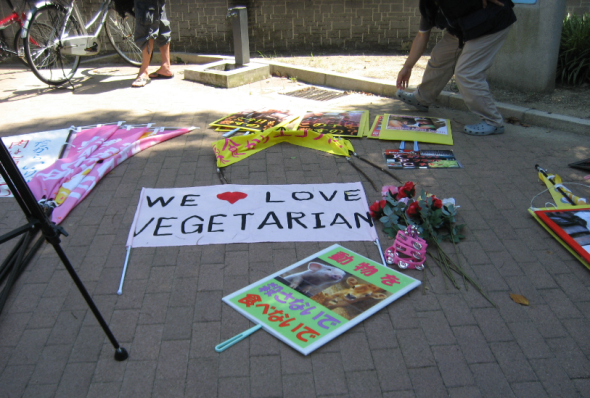
Harvey – Where have you been the most successful as an animal activist, for example, have you managed to change laws, have you changed the way a dog breeding farm works or have you stopped abuse in some other way?
Vivian – With Shiseido, the largest cosmetic company in Japan, which has stopped their Animal Testing (except for in China). JAVA started a negative boycott campaign to stop Shiseido’s Animal Testing in 2009. We conducted demonstration marches in front of Shiseido stockholder meetings in Tokyo and Osaka and asked stockholders to pressure the company to stop animal testing. JAVA also collected signatures through the Internet and a newspaper advertisement, and then handed over about 46,000 signatures to Shiseido. These activities were featured by the media , which attracted people’s attention the fact that animal cosmetic testing is a social problem in Japan. In March 2010, fter about a year after starting the campaign, Shiseido announced that they would begin an effort to abolish animal testing, and in Feb. 2013 they officially announced they would abolish animal testing for all their cosmetics (including materials and commissioning manufacturer) which they began two months later (except for China).
This was a huge victory for animals and for us. Many people’s voices moved the big mountain, Shiseido, and it proved that our movement and our activities were able to bear fruit.
Harvey – Vivian, what you and JAVA have accomplished is amazing and we thank you for so much for your dedication and hard work. People like you and those at JAVA show the world that the Asian community does care about animals.
So what has been your largest demonstration, why did you demonstrate and did it make a difference? I am asking why because it shows the animal welfare community outside of Japan how capable and passionate Asian activists are about making change.
Vivian – Our first demonstration against eating meat in Japan took place on July 18th, 2010 Sunday. This was the first demonstration against eating meat in Japan, and it played an important role in raising the awareness of the Japanese people.

Harvey – What are your thoughts about the fur and meat trade of dogs and cats?
Vivian – I am absolutely against the fur and meat trade of dogs and cats. Japanese people love dogs and cats, and most don’t know that dogs and cats are killed for fur and meat. I want them to know the truth. I think if the Japanese people knew the truth, they would be shocked and it would be an opportunity to think about those issues and stop them .
Harvey – Whenever Speak Up For the Voiceless.Org and many other animal and environmental organisations create awareness about the dog and cat meat and fur trade within Asia we receive such harsh racial slurs against Asians. The general public does not understand that those who do the abusing are only a minority and instead, they blame all Asian citizens. What are your thoughts on this and do you have a message to those people that brand all Asians as cruel to animals?
Vivian – I think the culture that eats dog and cat meat, as well as dolphin and whale, has to be criticized. However, in Asian countries, I guess many people think the culture is is comprised of elderly people and out of date - many don’t even know about the culture. I think if more people knew the facts they would see that this culture is wrong and not humane. I want those people who think all Asian people are cruel to know these things and that many people within Asia are also upset about this cruelty .
Harvey – When we document the cruel abuse that animals suffer within Asia we are met with comments such as, “boycott Asian products.” What are your thoughts about this and do you think it is fair for people to ask for this knowing that boycotts affect innocent Asian citizens and can potentially harm them economically?
Vivian – When we want to solve these problems, we have to consider doing more effective, productive and meaningful things and organize a plan. Products are produced because the consumer wants to buy them. I think if the consumer stops buying products made in countries that abuse animals or made from abused animals, the products will not be produced, so that can be effective, however, to boycott Asian or some other country’s products indiscriminately is not good or effective.
Harvey – Thank you for explaining that, Vivian. I do believe that if people boycotted products that are made from abused animals then this would be very beneficial . To boycott an entire country is not good or very effective and can have disastrous effects for many, even those who are actively fighting to stop abuse.
I see that you have been working on many issues such as anti-fur, anti-vivisection, no kill / adopting, vegetarian / anti meat-eating, animal welfare. Please describe what your role is with these projects and how influential you have been - have you made change happen, and if so, how did this make you and others feel?
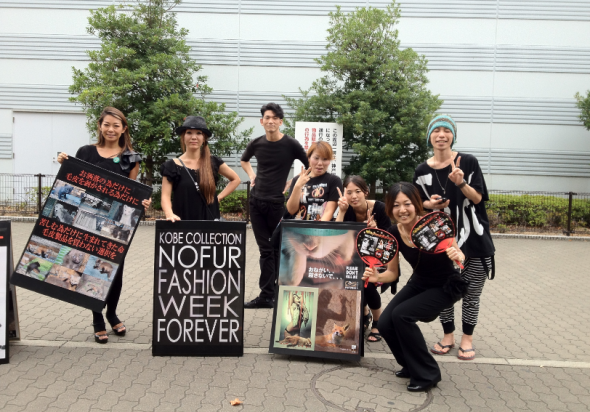
Vivian – I did succeed in spreading awareness through many actions and to many people through demo marches, panel exhibitions, leafleting, SNS, blog, BBS and so on. I’ve also appealed to many companies, administrations and governments etc. to save animals via stopping animal testing, killing dogs and cats, to making effective laws to protect animals and so on via telephone, fax, e-mail and mail, as well as offering information about living a cruel-free lifestyle by becoming vegan/vegetarian, boycotting products that use animal testing and promoting vegan products. One of our most successful actions was Shiseido’s Stop Animal Testing boycott campaign. I think it is most important to spread facts and awareness but also the facts on what and how to do even one little thing to help animals. Over the several years my fellow activists and friends have beenspreading these facts awareness I received so many reactions such as, “I was shocked I became a vegan/vegetarian,” or, “I didn’t know these facts, thank you for telling me,” or, “I will start doing something to help animals, like you,” or, “I want to join in your activities because I want to be voice of animals”. All of these comments encourage me and make me feel glad I have been doing these things . We have to continue widening the circle of awareness.
Harvey – Vivisection is an appalling act of animal abuse. What is your message to the European and American vivisectionists that take animals from Asia to use and barbarically torture?
Vivian – Honestly, I want them to stop every vivisection now since they are meaningless and wrong from the point of view of ethics and science and for people and animals. Also, the transportation of these animals, which places them in very stressful conditions for long periods of time, is unacceptable. Harvey – Your demonstrations in Japan look very effective and colourful Many activists across the globe often have issues with police suppression. . What are your thoughts on this and have you or a friend ever experienced police brutality?
Vivian – In my area most policemen are polite and good to us, as well as cooperative, as we are, so I have never felt bad around them. Some of them have actually praised our activities and our demonstrations .
Harvey – Vivian are you a vegetarian or vegan? What made you turn to (either) and why?
Vivian – I’m a strict vegan because I want to help animals and don’t want to eat them. Many animals will not be produced and killed if I stop eating or using animals. I stopped eating meat and became a vegan once I become aware of animal abuse and understood that many animal rights activists are vegan / vegetarian. I think veganism is a non-violent lifestyle, and to become vegan is just a starting point for me. For animals, environments, people and our earth, we can do many more and very simple things to put a brake on this mass production / consumption / destruction economy. We need to popularize being vegan.
Harvey – The Sea Shepherd Conservation Society have been actively making great progress against the whaling business by lowering kill rates and highlighting abuse. However, SSCS has come under great fire from the Japanese and other governments for its effective non-violent campaign. What is your position on the whaling business, do you believe that Japan must stop whaling to protect future marine conservation sites and mammals and what are your thoughts on the consumption of whale meat and why the Japanese culture should end it?
Vivian – I think Japan must stop whaling now for the conservation of the environment and the animals. Whaling is continued due to our taxes for political concessions and earns copious profits for only few people. There is actually a surplus on many whale meats, whichcauses low demand, so it is unnecessary.
Harvey – The International Animal Rescue Foundation has been actively fighting against the use of rhinoceros horn as pseudo medicine in the traditional Chinese medicine trade. . Rhinoceros in Asia and India are brutally slain for their horns, which are hacked off to feed this repulsive trade in Asia. What are your thoughts on this and do you have a message to say to the Asian and non-Asian Rhino horn medicine-using community?
Vivian – Hunting rhinoceros is so cruel and this abuse should never be accepted - we must stop it soon. Humands need to stop using animals for their own selfish desires.
Harvey – Every 15 minutes an elephant is barbarically killed in Africa just to provide ivory, better known as white gold. We are losing a staggering 35,000+ elephants a year due to the fact that many Asian individuals believe that the elephants tusk can be removed without killing the animal . What are your thoughts on this and have you demonstrated against the use of rhino and ivory parts, as well as the poaching of these two mammals?
Vivian – This is also horrible - hunting rhinoceros and elephant must stop now. A lot of substitutes already exist, so there is no reason to use real ivory. I have signed some petitions and spread these facts throughout the Internet to help stop this abuse.
Harvey – Millions of dogs and cats are left homeless every year internationally and locally within Japan because of animal neglect and abuse. What work have you done to promote a no-kill policy and the adopt, don’t shop philosophy?
Vivian – It’s so shameful that we have not stopped this kind of slaughter in our own country. The number of animals abandoned at (animal shelters) is still big. Most of them are unwanted kittens, so we have also promote sterilization http://ejje.weblio.jp/content/sterilization and castration operations to help control the unwanted cat population. Also, to stop killing animals, we have to abolish the commercial pet industry. I have been involved in many educational actions such as demonstration marches, leafleting, panel exhibitions and Internet awareness spreading as well as posting our demands to stop the needless killing of animals. Additionally, I have visited administrative facilities (animal shelters) that have many animals and kill animals and had meetings with those in charge. The Law of Humane Treatment and Management of Animals of Japan were revised slightly in 2013, but it is not strong enough and has not been used efficiently yet. We have to continue our educational activities, and make many more people understand why they should choose to adopt, not shop.
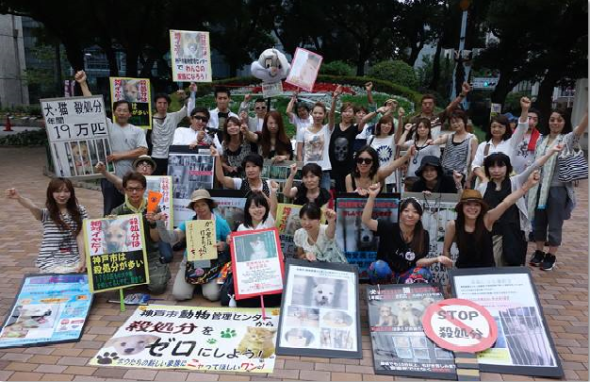
Harvey – That’s amazing, Vivian - your contributions and hard work are breathtaking. You really do show such love and compassion and possess such a strong voice for stray animals within your country and others. Well done!
I would like to take this opportunity in thanking you, Vivian, for answering my questions and to thank your fellow activists at JAVA for such outstanding work and achievements. It really goes to show that the Asian community does care, hates animal abuse and that there are only a minority of people that actually do kill and abuse animals. Knowing that few people within Japan are actually aware of such abusive regimes can only inspire us to promote and support all Asian activists and create more awareness about their works.
“ “My aim is not only to stop animal abuse but also to change our current mass production, consumption, destruction economy,” says Vivian. “I will fight to end the suffering of animals until the end of my life.”
Now who can say that all Asian citizens are animal abusers who will kill anything? International Animal Rescue Foundation and Speak Up For the Voiceless actively supports many Asian activists whose work to reduce animal cruelty and change laws to protect animal welfare we will continue to highlight. Vivian is a young, passionateactivist that has committed her life to animal welfare - we can’t thank her and comrades enough for working so hard to create such positive change for animals in their country .

